

Roger Hector interview
By Scott Stilphen
(2013)

Roger Hector started at Atari, way back in 1976. As an all-round creative designer, he was originally hired by Pete Takaishi (Industrial Design Manager), before working for George Opperman (Art Department head), and then finally for Al Alcorn (VP R&D). He managed Atari's Advanced Products Group and helped create the fabled Cosmos system before leaving to co-found Videa (later renamed Sente Technologies) with Howard Delman and Ed Rotberg. Since then, he's worked for several prominent companies - Electronic Arts, Walt Disney, Sega, and Namco Bandai... and he's not done yet!
Q: What’s your educational background?
Roger Hector: BS degree in Industrial Design – from the Art Center College of Design, Pasadena, California.
Q: What inspired you to pursue a career in game design?
Roger Hector: After graduating from college, I went to work for Huffy bicycles in Ohio. I was designing bicycles (loved it!), but did not like the weather in Ohio (too cold), so I wanted to return to California where I grew up.
Q: How did you hear about Atari?
Video games were a pretty new thing at the time. I had played some coin-op Pong, but did not know much about video games, or the company behind it. In 1976, an old college friend of mine (Pete Takaishi) offered me a job in the design department at Atari, and I jumped at the chance to return to California. Atari was looking for a designer and offered me the job and to pay for my move…which was all it took.
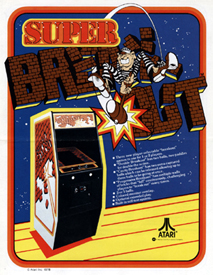 Q: Can you talk about some of the games and projects you worked on at Atari?
Q: Can you talk about some of the games and projects you worked on at Atari?
Roger Hector: There were so many projects at Atari (dozens!) that I can’t remember them all. My first one was to design the physical coin-op cabinet graphics for the game Super Breakout. But I moved into actual game graphics and game design for titles like Battlezone and Warlords. I was the 1st guy (that I know of) that created storyboards for games. I was familiar with the process of storyboarding movies, and it made sense to quickly sketch pictures of game screens to show its progression from beginning to end. I started drawing my own game ideas and presenting them at company brainstorming meetings. This led to others asking me to draw up their ideas, and I enjoyed helping them visualize their games.
I designed game cabinets and did some production artwork on Atari coin-op and pinball cabinets under George Opperman including: The Atarians, Airborne Avenger, Subs, Middle Earth, Space Riders, Superman, and Road Runner. Middle Earth was known as Lost World during development.
I had the idea for, and designed the 2 Game Module that was offered with several convertible game kits. It was sold to convenience stores (i.e. 7-11) where floor space was at a premium. These were called: “Street Locations” and were a larger market than arcades. It put two games in the floorspace of 1, and I received a patent on it. I also did a cocktail table cabinet that went with it. There were 6 – 8 game kits that could be easily changed out with drop-in control panels, game boards, and compatible wiring, and it became the first convertible coin-op game "system". The only titles I remember were Breakout and Pool Shark.
Q: Pool Shark is a pretty rare b&w game to find these days...
Roger Hector: I had one at home and my wife got too good at it. I couldn't beat her!
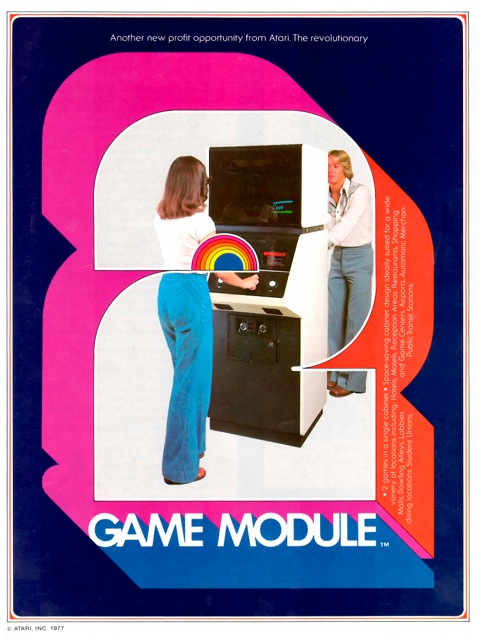
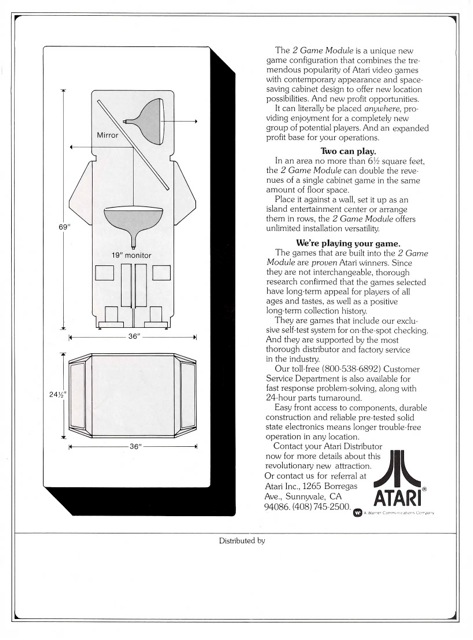
2 Game Module arcade flyer
Later, I managed the Advanced Products Group that worked across all areas of the company, from Coin-Op to the Consumer division. I remember building the first large projection screen coin-op racing simulator. It was called Indy Turbo (the early name for it was "Indy Racer"), and it actually looked like a Formula 1 race car with a big projection screen in front of the driver.
Q: That sounds very similar to Namco’s F-1 mechanical projector game, which was licensed to Atari to manufacture for the U.S. Besides the Indy car-shaped cockpit, what other differences were there between the prototype game and F-1?
Roger Hector: Our racing game built in the Research & Development labs was similar, but different from the Namco game. I led the design along with Harry Jenkins. Harry was a very creative mechanical engineer, and we made a good team. We had this very special "hot rod" video projector given to us by the manufacturer for evaluation in R&D. It was an early (Electro-Home?) water-cooled video projector (Ed.: Jeff Anderson of Videotopia had some information about the projector - "It's an Electrohome EDP-58. They were in production for at least a couple years, and used a single green Sony SD187 CRT. It was designed as a "data" projector, to be hooked up to computers like the Apple II."). We couldn't let it just sit around, so we built it into a special beefed-up race car body and put an old game (Night Driver) into it, projected onto a five-foot screen, just to see what it would do in the field. It looked pretty cool as it resembled a real formula racing car and it had a special seat that leaned into the turns as you drove. The player’s seat was rigged to rock a couple inches tied to steering wheel inputs, and this physical movement during play would add to the sense of being in a moving/leaning car (not sitting on a fixed bench). We used a whole racing car (front to back) and mounted the video projector behind the driver and projected it over his head onto a larger projection screen mounted over the front axle of the car.
Before going out in public, we wanted to make sure it would hold up to abuse, so we called on the biggest guy in Engineering, Dave Stubin, to check it out for durability. We presented our beautiful shiny new race car to him, confident its construction was worthy, and he promptly raised his foot and stomped it on our car, breaking the gas cap off, and breaking our hearts! Now, Dave was a really BIG guy, and this became known as "The Stubin Test". It was pretty useful for making sure coin doors and controllers would hold up in the field.
After some further rebuilding, Indy Turbo went out on location in a local arcade and amazingly (despite having an old low-tech game in it) became an instant hit and the all-time top earning coin game at this local amusement park. The unique cabinet design is what really drew in the players, as it looked like a complete race car, and not just a box, screen, and steering wheel. But it was using a prototype video projector that never went into production, so we could never produce it. We would not have used it past our prototype Indy Turbo anyway, as it was pretty fragile and would not have held up well in a real commercial coin-op location.
Here's some photos of the prototype out in our parking lot:
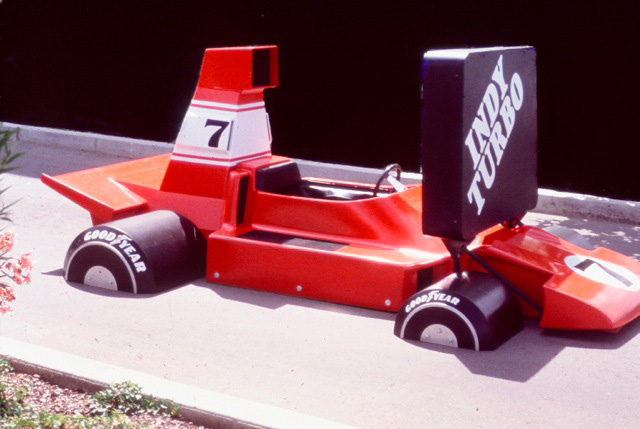
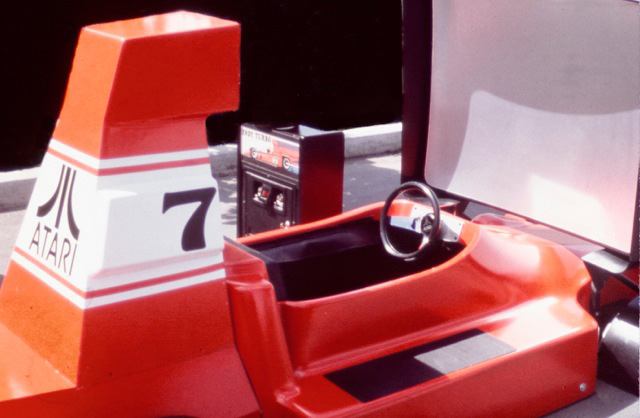
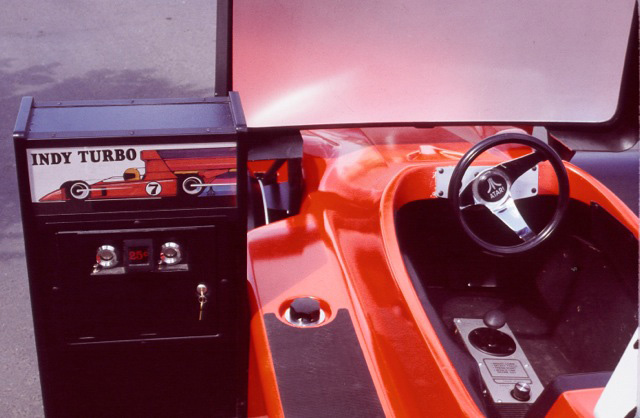
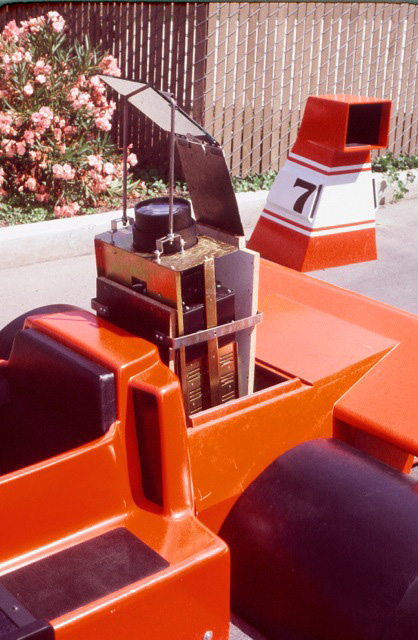
Dragster was an early concept sketch that used rear-screen projection and a vibrating seat. We wanted to have it do a wheelie, but decided the screen was too small and never got to it:
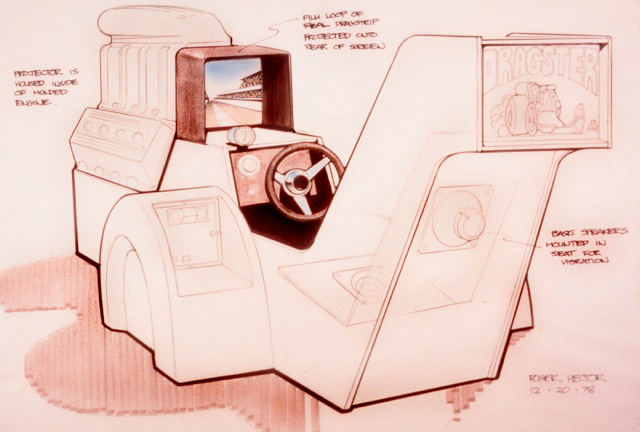
Cafe Racer was a new coin-op idea that let the player lean the motorcycle for extra speed in the turns. We never got to build it, but several other companies subsequently did.
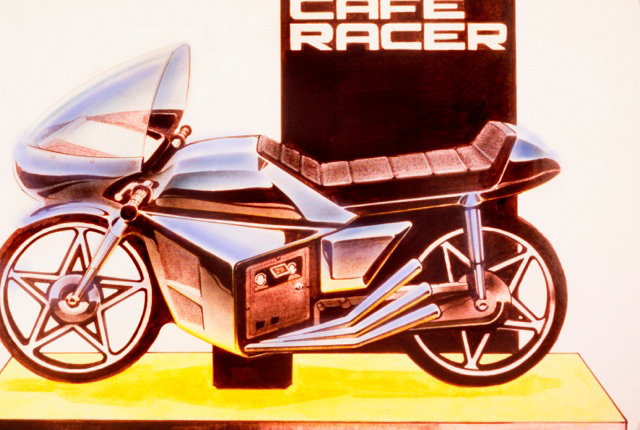
Q:
These screenshots were from a 3-part series that
CBS Channel 8 in San Diego filmed in 1982 that showed the following sketches of
yours - Atari 400 kiosk, a Star Wars-like helmet, and a Star Raiders command
center. Your Indy Turbo game also appears:
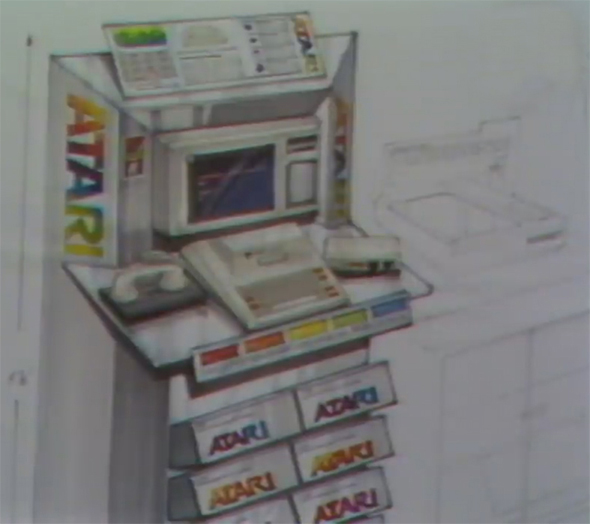
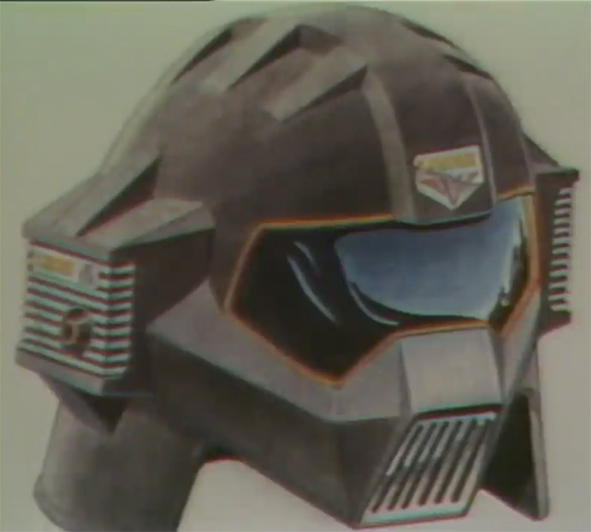
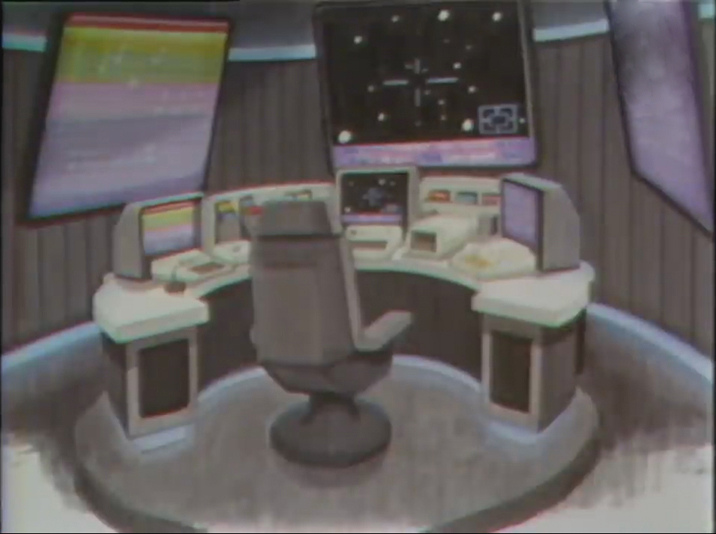
Roger Hector:
They were just a few of the idea sketches and prototypes of various projects I
started.
The helmet was for an advanced 3D audio system synchronized to an outside
projected video display that emphasized the illusion of 3D.
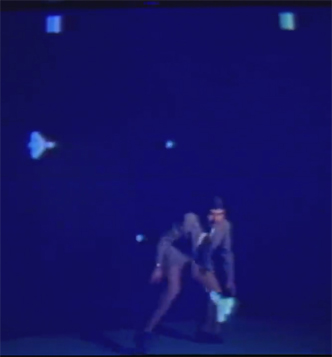
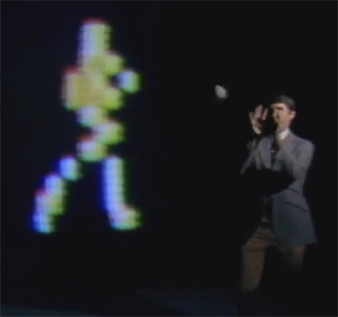
Q: The reporter did a few segments where he was filmed against a projector screen, with one segment showing the jets from Combat "chasing" him around, and another with him catching a ball from the animated baseball pitcher from 5200 RealSports Baseball (that Jerome Domurat was later shown working on the animation for). What was the projector room typically used for?
Roger Hector: Atari wanted to do special new game and computer product presentations, and we decided to build a cool place for this to happen.
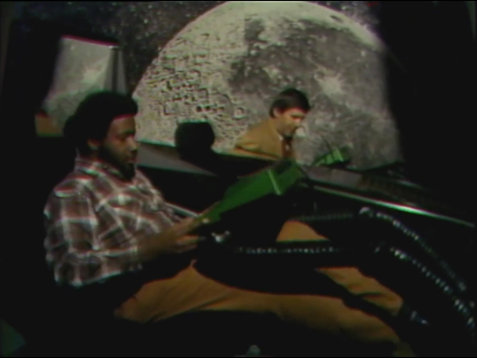
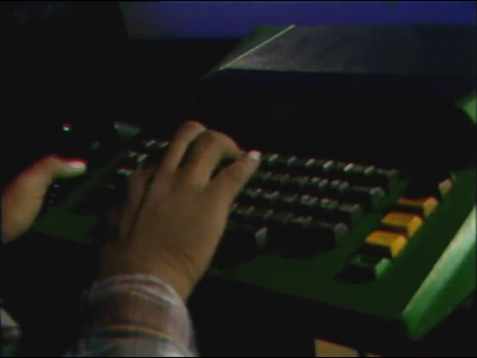
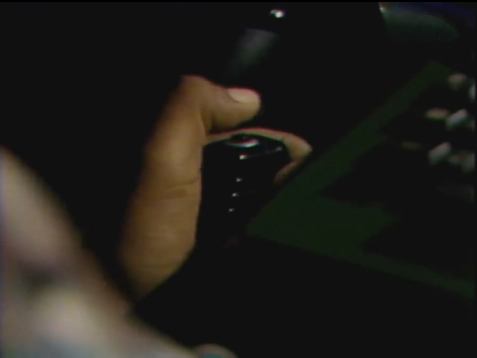
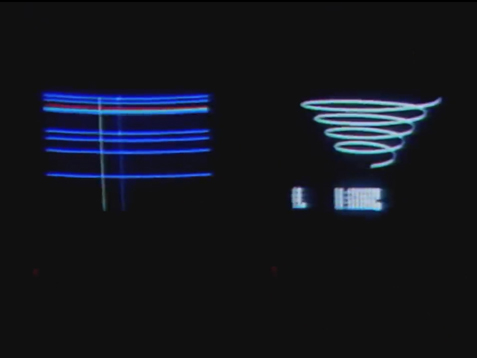
Q: In the 3rd segment, what was that custom 2-player Star Raiders (the reporter referred to it as Star Fighter) setup? Both players had their own green (?) Atari 800 computer, and Engineer Sherman Kennedy is shown pulling back what looks like a Battlezone or Red Baron-type joystick. It looks like the Star Raiders setup used 2 monitors, but some of the game footage shows graphics that aren't in the original game. How did the green Atari 800 computers interface with it, and what was the game running on? It appears to have used 2 monitors, and an Atari 800 typically can't support driving 2 monitors. Perhaps a custom computer (or a VAX) was running the game? Was the original Star Raiders designer Douglas Neubauer involved with this version?
Roger Hector: Sorry. I can’t remember very many specifics on this. This is one I don’t think I was involved in. I don’t think Douglas was involved in this specific version, and I doubt it was a VAX.
Q: The reporter mentions this game setup was created for a show that was in Las Vegas. Do you recall anything at all either about the game setup or the show that was referenced?
Roger Hector: I think this references the now cancelled AMOA (Amusement / Music Operators) show which was originally based on jukeboxes and focused on coin op games and held twice a year in both Las Vegas and Chicago.
Q: By all accounts, Atari’s R&D department was legendary, but sadly, most of those reflect on how many innovative and ground-breaking projects and ideas sprang from there, only to be relegated to the pages of history, or in a few cases, eventually see the 'light of day' years or decades later in a different form - one being Cosmos. Al Alcorn stated several times that Atari’s lack of faith in Cosmos was pretty much the deciding factor on him leaving Atari. Is that why you ultimately left?
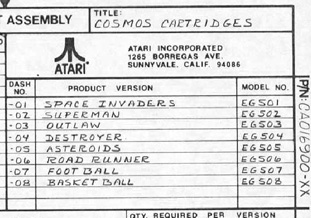 Roger Hector: Yes, that was pretty much the end for me.
Cosmos was the first commercial use of holograms. We had conceived of and patented (Ed.:
Cosmos Patent) a whole new technology (mass-producible holographic displays,
something that had never been done before), and created a finished tooled product that was supported by 8 finished games (Asteroids, Basketball, Destroyer, Football,
Outlaw, Road Runner, Space Invaders, and Superman).
Roger Hector: Yes, that was pretty much the end for me.
Cosmos was the first commercial use of holograms. We had conceived of and patented (Ed.:
Cosmos Patent) a whole new technology (mass-producible holographic displays,
something that had never been done before), and created a finished tooled product that was supported by 8 finished games (Asteroids, Basketball, Destroyer, Football,
Outlaw, Road Runner, Space Invaders, and Superman).
Q: A press kit labeled Electronic Entertainment has a flyer that lists 9 games, and a letter that mentions there were 8 (but only lists 7). Two different titles mentioned were Dodge 'Em and Sea Battle. Were either of those being worked on, or were they simply vaporware?
Roger Hector: There were a number of brainstorming sessions that considered other games, but the original 8 were the only ones worked on. The strategy was to have all of the games programmed into the base unit so that we could take the cost of electronics out of the cartridges. That’s how we would be able to sell the individual games so inexpensively. It would be a closed system after launch, but this would give us a chance to get this new technology into production and learn about potential pitfalls. This is why we saw Cosmos as only a 1st stepping-stone to other things downstream.
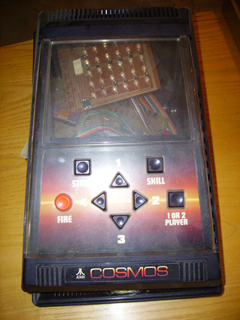
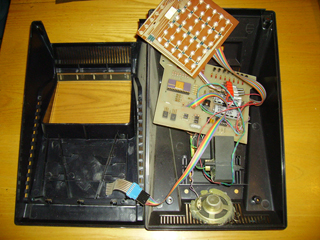
Rare early variant of Cosmos handheld (disassembled), which was used by Atari's Marketing
department for promotional material. Click on images for full-resolution. Photos courtesy of Al Alcorn.
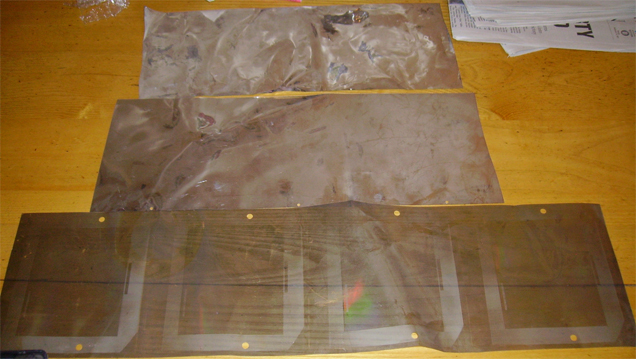
Hologram test sheets. Photo courtesy of Al Alcorn.
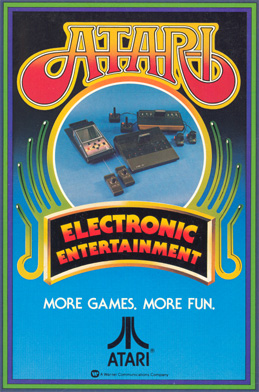
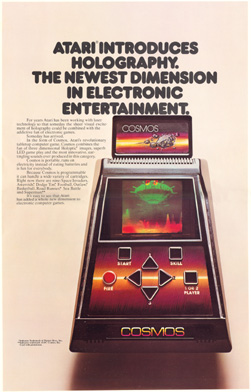
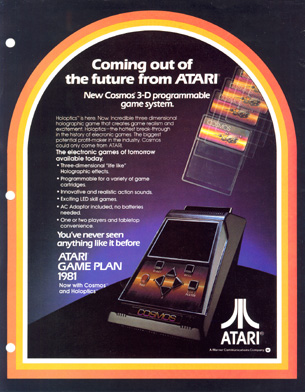
Atari 1981 press kit cover and Cosmos flyers.
Q: Was the Cosmos development team primarily just Al Alcorn, Harry Jenkins Jr., and yourself?
Roger Hector: It started with the three of us, and then we added the Holoptics Lab team. Under Al, Atari acquired all the patents in display holography, so they had the existing intellectual property locked up. After buying all the holographic patents, setting up a "secret" laser lab away from the rest of the company, and hiring some high-powered scientists to run the "tank Killer" laser, a very complex embossing technique was perfected, and holograms could finally be made for pennies apiece. Previously, holograms had to be individually developed (like photo prints), which was unsuitable for large-scale production. Steve McGrew solved the problem with a breakthrough embossing technique. We applied for patents on this, and then we started designing and prototyping several holographic toys from handhelds to the Cosmos game system.
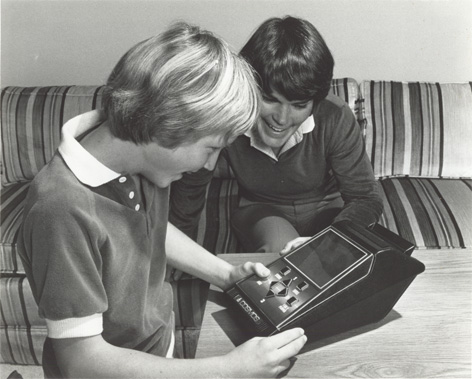 We brainstormed designs for both flat and cylindrical animated holograms. It was all about experimenting and breaking new ground. Cosmos rose to the top. The Cosmos concept featured multi-image flat hologram cartridges superimposed over a LED matrix. The LEDs lit
up silhouette pictures themed to the game and they appeared merged with the holograms. There was nothing like it. It was very inexpensive to produce, and it blew away the competition in this category.
We brainstormed designs for both flat and cylindrical animated holograms. It was all about experimenting and breaking new ground. Cosmos rose to the top. The Cosmos concept featured multi-image flat hologram cartridges superimposed over a LED matrix. The LEDs lit
up silhouette pictures themed to the game and they appeared merged with the holograms. There was nothing like it. It was very inexpensive to produce, and it blew away the competition in this category.
As it got closer to production, there were additional people assigned from the Consumer Product division. Roy Nishi did the final industrial design, but unfortunately I cant remember the names of the other guys that did the production hardware and software engineering (my fuzzy memory). Our group was responsible for establishing the specs and making the holograms themselves, and a larger, separate group did the production design, put it in a box, and planned the marketing.
It went all the way through production tooling and pilot production with 8 game cartridges. We showed Cosmos at the 1981 Winter CES and Toy Fair shows, and took a year’s worth of production orders at the shows. But subsequently, Management inexplicably decided to not release Cosmos. The official reason, as told to me directly by Atari's CEO Ray Kassar, was that Atari overbooked orders for the VCS and needed more production capacity. Ray had decided to "hold off" on Cosmos "for now". This sounded to me like it was being permanently shelved. R&D was not a good place to be if the company did not want to produce new things. Even though it was fun creating new products with such a great team, I decided it would be more fun to get things out of the lab and into the market, so I left.
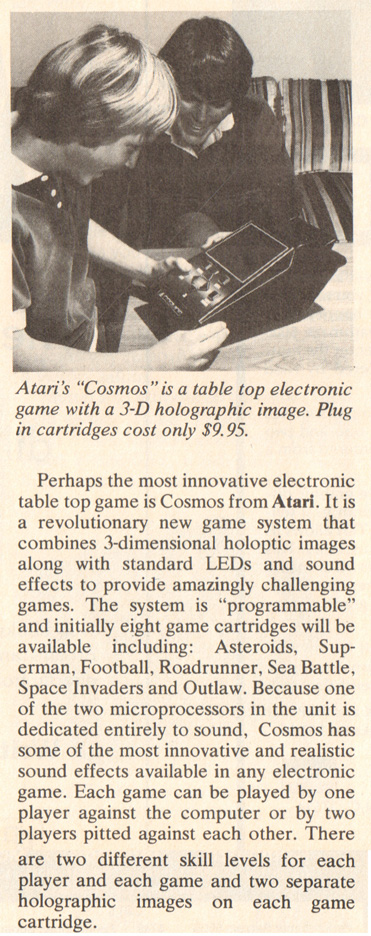

(RIGHT) Creative Computing March 1981 Winter CES news blurb (pg. 70); (LEFT) Electronic Games
news blurb from their Winter 1981 issue
Q: I'm not sure I believe Kassar's excuse. I think most of Atari's production at the time was already being done in Taiwan and Hong Kong, at least as far as VCS consoles and games were concerned. A more likely reason would have been either he considered the handheld market too small and not worth the effort, or handhelds too "low-tech" of a product, and not a worthy successor to the VCS, and releasing it might
possibly affect the public's perception of Atari, which if true, was an unfounded fear at best. Given how hot the VCS was in the market at that time, he probably had a case of 'tunnel vision' and only wanted to focus on that. Considering all the time and money spent on getting the Cosmos developed to that point, not to mention already having pre-orders for it, why not just release it and at least try to recoup your investment?
Roger Hector: Your speculations on Kassar's motives are probably about right. Cosmos was not a successor to the VCS. I certainly didn't see it that way. I saw it as a first step towards a new type of interactive game display that certainly raised the bar of image quality, had real "magic", and had a lot of potential to build on. I thought we would make a profit with Cosmos, but holography would be a bigger game changer downstream. We already solved some very tough problems getting it this far, and we were miles ahead of anyone else. The future seemed pretty bright.
I've read a few criticisms online of Cosmos like, "It wasn't produced because the games sucked." Actually this wasn't true. What people don't realize today is that Cosmos was going to be marketed as a cutting-edge, exotic, electronic toy, not a low-end video game console. This makes a big difference.
The hologram carts could be sold at a profit for $10, compared to several times that for video game carts. The base unit costs less than half of the cost of a VCS. It was targeted to a younger audience and priced in the Electronic Toy category. Against the other handhelds of that time, Cosmos' games blew them away! It was completely unique, and focus tests were good. I guess we'll never know if the Cosmos strategy would have worked in the market, but we did everything possible just short of getting it there.
Q: Cosmos was a huge leap ahead of anything else available, and neither Mattel nor Coleco - the 2 handheld "giants" at the time - had nothing even remotely as cool.
Roger Hector: We had more, different, and better holographic game ideas in the wings, too, but as I said, Atari didn’t want to actually launch anything new. This was bad news for R&D. First Al left, and then I left, and then Atari wound up dismantling the whole group. Atari’s holography technology and product designs were lost in the dismantling.
But the technology resurfaced shortly afterwards as our people moved into other companies and businesses, and embossed holograms caught on. We see embossed holograms everywhere today and don’t give it a second thought, but there was a time when this was all completely new, and all the technology for printing holograms - from credit card stickers to decorative film - originated at Atari.
Q: Do you recall any details about the "next generation" hologram games that were being developed?
Roger Hector: Here's a photo of the animated model we created for an advanced hologram game beyond Cosmos. I'm pretty sure this has never been seen outside of Atari before:
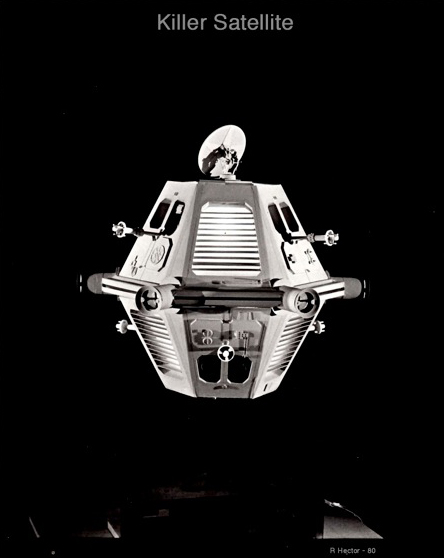
The "Killer Satellite" did not have a project name, but it was a space satellite that rotates inside a lenticular (drum) hologram, and the player had to learn how to shoot it down. This physical model was about 4 feet tall. It was internally lit and fully animated (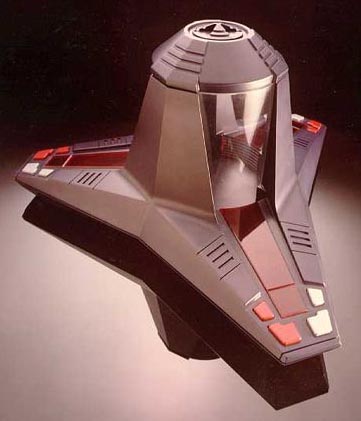 remotely-controlled
by wires) while being filmed. It was filmed in action on a stage set up in Atari's Holoptics lab. I thought I had other shots showing our staff operating the various pieces of the satellite from off-stage, but I couldn't find them.
remotely-controlled
by wires) while being filmed. It was filmed in action on a stage set up in Atari's Holoptics lab. I thought I had other shots showing our staff operating the various pieces of the satellite from off-stage, but I couldn't find them.
A lenticular drum hologram is where each frame of a 35mm film is compressed into a vertical lens (line), and is stacked next to each other on to a strip of clear plastic. By wrapping the plastic into a cylinder, and illuminating it properly, the net effect was that of looking into a clear vertical cylinder and seeing a 3-D scene or object inside. By rotating the cylinder in front of you, the viewer sees different frames of the film, and it becomes nicely animated. In the case of the "Killer Satellite", it would slowly revolve, the dish antennae would revolve in the opposite direction at a different speed, the guns would swing to fire at you, and the internal lights would come on to indicate which were shooting at you and which targets were available to shoot. The player had to learn when to attack and when to defend. This all happened visually inside the hologram image which stood about 4 inches tall inside the clear cylinder, and you could see all around it for 360 degrees. I wanted to experiment with multiple superimposed films with multiple light sources, which would give you several parallel tracks of animation and would allow for more interaction and more gameplay, but we never got the chance. It's pretty obscure now, but at the time we had big plans.
Q: There's a photo floating around the internet of an electronic game system, called Specter or Spector, that looks as though it might use a drum. Is that what this is?
Roger Hector: After seeing that photo, it dawned on me that this was a prototype model was made to house the "Killer Satellite" game. The Spector model never worked, but it was designed by Roy Nishi in Consumer Products. I remember illustrating a few different approaches for 1, 2, 3, and 4-players. Spector was a 3-player game.
I did dozens of concept sketches showing different handheld hologram ideas. Here's one called Diamond Dust:
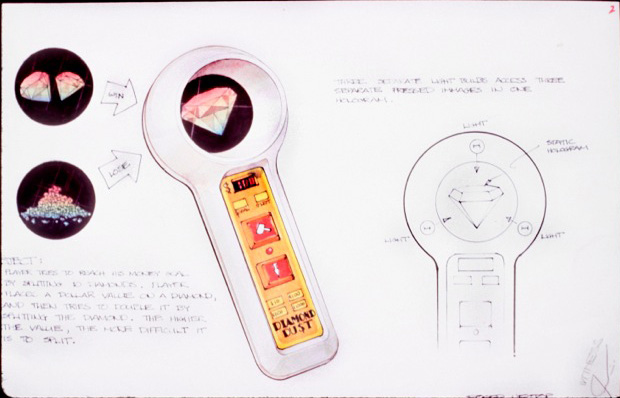
Q: The Cosmos and Spector holograms are the earliest examples I know of where models were used for game development. Imagic used custom "kit-bashed" models for their advertising and packaging. Were the Cosmos and Spector models created in a similar fashion, or were they comprised of parts specially created for it?
Roger Hector: Because of its large size, complex animated movements, and internal lighting, the "Killer Satellite" was completely custom-made from scratch. But some of the models used for Cosmos were kit-bashed where practical. I designed and built all of the models used to make all the holograms.
All the Cosmos games used 2 models (1 for each scene) that were superimposed on top of each other and individually lit when needed by 2 light bulbs inside. For example, with Football and Basketball, each scene was one half of the field (left and right) and the scene would change automatically when you moved into an opposite side. Shooting a basket required hitting the LED that aligned with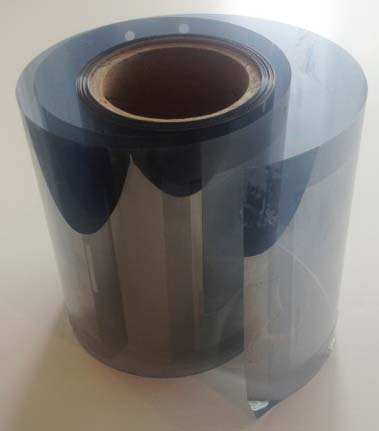 the hologram basket, and kicking a field goal required hitting the LED between the goal posts. Other gameplay was integrated to the model where possible. In Superman, the objective was to catch invading dragons above Metropolis and drag them below to fill the underground dungeons. They could escape or knock Superman down, but when the dungeons were filled, you received a score based on the time you used. Destroyer featured a top-down view of two battleships which shot at
each other from different deck guns. Playing required learning a progressive sequence of cannons to attack and block with increasingly critical timing. Defeat triggered a scene of an exploding battleship with parts flying everywhere and sailors jumping into the sea. Other games used the holograms more as environments for the scenes and would show "Game over… you lost". However, there were a variety of game styles, and we felt we would blow the
socks off the field of electronic handheld toys.
the hologram basket, and kicking a field goal required hitting the LED between the goal posts. Other gameplay was integrated to the model where possible. In Superman, the objective was to catch invading dragons above Metropolis and drag them below to fill the underground dungeons. They could escape or knock Superman down, but when the dungeons were filled, you received a score based on the time you used. Destroyer featured a top-down view of two battleships which shot at
each other from different deck guns. Playing required learning a progressive sequence of cannons to attack and block with increasingly critical timing. Defeat triggered a scene of an exploding battleship with parts flying everywhere and sailors jumping into the sea. Other games used the holograms more as environments for the scenes and would show "Game over… you lost". However, there were a variety of game styles, and we felt we would blow the
socks off the field of electronic handheld toys.
Building Cosmos models was a challenging process of invention. The scale and placement of objects in the finished scenes had to line up with the proper LEDs in the matrix. As the optic geometry used by our holographic scientists (Steve McGrew and Ken Haines) distorted the images, it required the models be built "pre-distorted" in reverse, so they would appear naturally as they were intended in the game. The models also had to be built of materials that were rock steady as ANY vibration or movement during the exposure (a couple of minutes) would ruin the image. This meant they couldn't vibrate or even thermally expand the distance of ¼ of the wavelength of light. That is a very small amount! This meant that I couldn't use materials like cardboard or fabric because they would just expand or contract too much, even though the whole lab was designed to dampen vibration. After experimenting around, I eventually was able to build models that would fit our optic table set-ups, and hold still for their picture.
Q: Do you have any video of the model being animated, or the model itself, or any Cosmos material for that matter?
Roger Hector: I only have that photo of the "Killer Satellite" model, but not the video or the hologram. I held onto 5 or 6 of the pilot production Cosmos units. Unfortunately a few years ago my wife cleaned out the garage and threw away the Cosmos units! After all, they were old and didn't work... right? Actually they would work if there had been any production cartridges, but I had none. She was shocked when I told her that these were possibly worth $thousands apiece, but it was too late. :( I did find a production roll of Cosmos Space Invaders holograms. I'm not sure how many holograms are on the roll, but it looks like there are at least a couple dozen. This is how they were embossed - on a half-silvered acrylic roll. I haven't looked at this stuff in years, but I thought I would try to illuminate one of the images and take a picture for you. This turns out to be much tougher than it sounds as it requires a specific alignment to a point-source of light (in this case, a flashlight) and I was trying to hold the light precisely and take the picture at the same time in a dark room. Holograms are practically impossible to take photographs of anyway, but here is the best I could do to show the two images on this hologram from the roll. I know it looks grainy, but when it's lit and viewed properly, the image is quite clear and detailed:
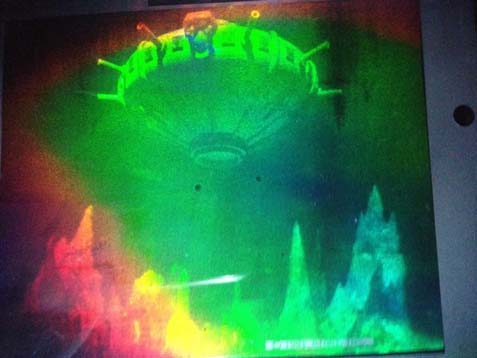
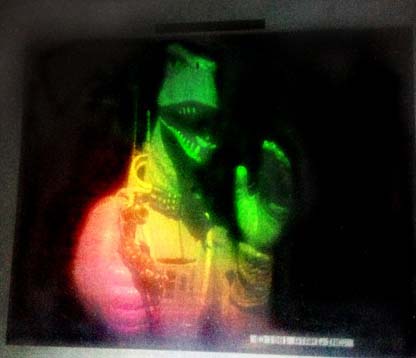
Cosmos Space Invaders hologram images.
The left image is the main game backdrop: a hovering saucer over a lunar landscape. It played like Space Invaders with columns of aliens (played by LEDs lighting up character silhouettes), and you move a gun back and fourth at the bottom shooting up. When an alien landed, the scene switched and gave you a close up of him with his gun pointed at you (right image), along with a musical flourish and flashing lights.
Q: The story is, Asteroids (the arcade game) was called "Cosmos" early in its development. Was there any relation to that and the Cosmos handheld? Since Asteroids was to be the pack-in game for Cosmos, was the system perhaps originally intended to play only one game - Asteroids?
Roger Hector: My memory is that Lyle Rains directed the original coin-op Asteroids, Ed Logg and Dominic Walsh programmed it, and Howard Delman designed the hardware for it. I only bothered them in their lab by playing it incessantly while they worked on it. The coin-op team didn't have anything to do with the Cosmos version of Asteroids, as Cosmos wasn’t until much later, and Asteroids was already established as a big hit. I don't clearly remember exactly when all this stuff happened (on the calendar, anyway), but Cosmos was all between 1978-1980. As I recall, the sequence of events for Cosmos went like this:
1. Al Alcorn started this by asking Harry Jenkins and I to think up some potential consumer applications for holography, while at the same time, he was working on acquiring the Holosonics patent package. Al saw the opportunity to have this technology secured and proprietary to Atari, and we saw the opportunity to creatively break new ground.
2. With the underlying patents secured, and some product directions being explored, Al brought in Steve McGrew and built the Holoptics Lab to solve the problem of mass producing (embossing) the holograms. This grew into a small team of scientists and technicians housed in a "secret" lab location in Sunnyvale with some high-powered lasers, optical tables, and various tech gear. And they got this key job done.
3. In parallel, Harry and I created & sifted through several different product ideas, and with Al, settled on the Cosmos concept (several cartridge games in a tabletop player). All this concept and tech development was done in Al's R&D division.
4. The Consumer Products Division Engineering group was pulled in to do Cosmos production engineering for hardware, software, industrial design, packaging, etc. Our group did all the production work on the holograms, and eventually we were all working together as one big team.
Q: I found a podcast from April 2010 that talked about the Cosmos, and said Steve McGrew's company, Light Impressions, was an early pioneer in holographic imagery, and made it sound as though he either left his company to work for Atari, or his company worked alongside Atari with
their Holoptics lab. Although, another site I found indicates he worked at Holex Corporation prior to Atari.
Roger Hector: My recollection is that Steve owned Light Impressions and contracted with Atari for the work there. When Ray Kassar shut down the Holoptics lab, Steve bought Atari’s lasers and lab equipment (cheaply), and returned it to Light Impressions in Santa Cruz. He successfully made decorative holographic film stickers for years afterwards.
Ken Haines was a holography / laser scientist who worked closely with Steve in the Holoptics lab. I recall that they were colleagues, but Steve was responsible for the breakthrough work and was the leader in the lab.
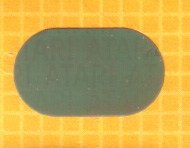 Q: Rumor is the only practical use that Atari ever saw from the Holoptics lab were the little hologram stickers they started
putting on boxes. These first started appearing on VCS boxes October 1982, and were used up until 1984. They've been called a 'security feature', but they seem less of a security feature, and more of something used to denote an 'official' Atari product.
Q: Rumor is the only practical use that Atari ever saw from the Holoptics lab were the little hologram stickers they started
putting on boxes. These first started appearing on VCS boxes October 1982, and were used up until 1984. They've been called a 'security feature', but they seem less of a security feature, and more of something used to denote an 'official' Atari product.
Roger Hector: Actually, Atari's little security stickers were not produced at Atari - maybe by Steve McGrew's Light Impressions?
After Ken Haines left Atari, I heard he went to work for American Banknote which prints official securities papers like currency, stamps, stock certificates, checks, etc. They would have a huge interest in irreproducible printing. While there, Ken created the first holograms on credit cards, and later the first embossed hologram that appeared on the cover of National Geographic magazine in 1984. Today everyone has a printed hologram in their pocket - on their credit cards!
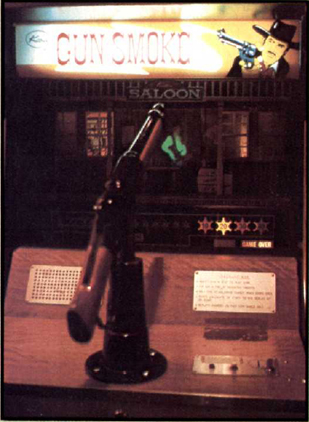 Q: An article concerning
holography appeared in the February 1983 issue of Electronic Fun with Computers and Games magazine (pages 68-73). The article states Light Impressions made 250,000 holograms in 1982!
Although there's no mention of the Cosmos, it mentions "Coleco and Atari are
working on holographic games, but chances are you won't see one for awhile." It also mentions a Japanese company called Kasco produced an arcade game called Gun Smoke that used a hologram (the
flyer mentions it's the first hologram 3-D game), along with 2 other games: Samurai and Bank Robber. There's a video of Gun Smoke on YouTube, but it doesn't show the hologram very clearly. The game is clearly EM-based; one site even claims its release date was 1970! Midway also produced one in 1976 called
Top Gun (flyer and video).
Q: An article concerning
holography appeared in the February 1983 issue of Electronic Fun with Computers and Games magazine (pages 68-73). The article states Light Impressions made 250,000 holograms in 1982!
Although there's no mention of the Cosmos, it mentions "Coleco and Atari are
working on holographic games, but chances are you won't see one for awhile." It also mentions a Japanese company called Kasco produced an arcade game called Gun Smoke that used a hologram (the
flyer mentions it's the first hologram 3-D game), along with 2 other games: Samurai and Bank Robber. There's a video of Gun Smoke on YouTube, but it doesn't show the hologram very clearly. The game is clearly EM-based; one site even claims its release date was 1970! Midway also produced one in 1976 called
Top Gun (flyer and video).
Roger Hector: I've never seen or heard of the Kasco arcade games, but the Gun Smoke game clearly looks like it uses a drum hologram (like "Killer Satellite"). I think it was likely produced much later than 1970 though. I've never seen Midway's Top Gun game, either. Though a bit crude, I have to hand it to them for giving it a shot!
Drum holograms were fairly easy to make. We were set up for it in our lab, and we even made some of ourselves goofing around for the camera. This was just part of casual experimentation at the time, but I wish I had one of those now.
Q: Someone named Peter Claudisu created "...several coin-operated sex machines using holographic imagery" circa 1976-1978 (site 1 and site 2).
Roger Hector: That's truly weird. I remember we produced some decidedly non-sexy animated rainbow holograms in the labs at Atari, including one of members of the staff. I don't remember what happened to it, but I'd love to see ourselves again "holographically" - 35 years later!
Q: I'm surprised nobody thought to create a coin-op game using the same design as the Cosmos, beyond Kasco's and Midway's early efforts. Atari always had the benefit of building on the popularity of their arcade games when it came to making home versions. Given how cool some of the mirrored backdrop displays were in some of the old coin-op games, having a big hologram behind a mirror with lights would have been a visual knockout. The only other arcade game that used a hologram that I'm aware of was Bally Midway's Creature from the Black Lagoon pinball game in 1992 (flyer).
Roger Hector: I agree that some of these ideas could be scaled up to make some spectacular coin games. The arcade environment was a good one to test gameplay as either kids like it quickly, or they don't at all. You can't get away with selling something in coin-op that isn't fun. A lot of coin-op principles were built into Cosmos, and the larger materials budget would have allowed for some amazingly unique attractions. It's too bad we never got the chance.
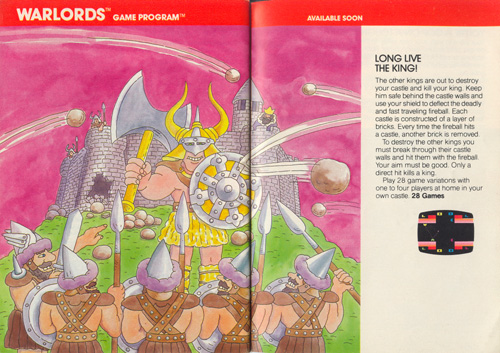
Q: There seems to be some question as to whether Warlords began first as a VCS game. You mentioned an interview you did back in 2005 that, "Warlords and Battle Zone were both created as coin-op games first, and they later made their way to the consumer consoles." Carla Meninsky, who programmed the VCS version, stated in an
interview, "I would like to set the record straight here - I did the 2600 game before the coin-op game even existed! I think that was the first time a coin-op game derived from the console game." According to the MAME notes, the arcade version was released April 1980; the VCS version didn't appear in catalogs until early 1981 (and was listed as "available soon") - more than 6 months later. An
article in the 1st (Winter 1981) issue of Electronic Games magazine (pg. 64) describes the arcade version as a "newcomer", making it sound as though it came out well after the VCS version. An article from the May/June 1981 issue of
A.N.A.L.O.G. magazine (pg. 25) mentions the home version was due out in June, but the writer noted that "I've seen an arcade version of this and it looks pretty good."
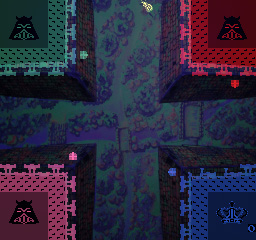 Roger Hector: I remember various lists of game ideas floating around Atari. They were the natural outcome of the traditional Atari
brainstorming meetings.
Roger Hector: I remember various lists of game ideas floating around Atari. They were the natural outcome of the traditional Atari
brainstorming meetings.
Regarding Warlords, I remember in 1979 I was sitting at home watching TV with a sketch pad in my lap (I did this often), when I had this idea to sketch a multi-player game that wrapped Breakout-style brick walls around each screen corner, and had players defend their "castle" from balls with a paddle. The fireball would speed up, knocking out bricks in the castle walls, and a player was out when their king icon was hit by the ball. The last king standing was the winner.
It was a simple, complete concept that sounded like fun.
I sketched this out and later formally presented it on a large storyboard at an offsite coin-op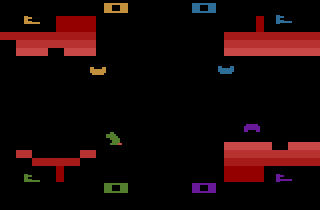 brainstorming session. These brainstorming sessions were done periodically, and I was a contributor and always brought illustrations. I called
it "Kings in the Corner", and the whole concept went over very well at the meeting. It was put on a list of "Good Ideas" for the future, and I heard nothing more about it until later when I heard that someone in coin-op had actually built it. It was going out on field test as Warlords. Clearly it was the exact concept I presented, but I had no involvement in the actual production of the game and received no subsequent credit. This wasn't unusual back then, and I
was just happy that it was made at all.
brainstorming session. These brainstorming sessions were done periodically, and I was a contributor and always brought illustrations. I called
it "Kings in the Corner", and the whole concept went over very well at the meeting. It was put on a list of "Good Ideas" for the future, and I heard nothing more about it until later when I heard that someone in coin-op had actually built it. It was going out on field test as Warlords. Clearly it was the exact concept I presented, but I had no involvement in the actual production of the game and received no subsequent credit. This wasn't unusual back then, and I
was just happy that it was made at all.
I was not in the loop of assigning projects outside of R&D, but I'm pretty sure it started in coin-op in 1980, and was done later for the VCS in 1981. I'm sympathetic with anyone trying to remember these details clearly after 30 years, but I can clearly remember I was watching Charlie's Angels on TV while creating this. I wish I'd held on to the storyboard, and I wish I could remember other things that are much more important! :)
Q: Do you recall any other interesting projects at Atari that were never released?
Roger Hector: One such concept was the Pro Vision. This was a fully-working prototype that included all of Atari's consumer library at the time in one rolling end-table cart. It was a high-style design with all the game ROMs on one board, all controllers in bins, and the games were selectable via capacitive touch switches on top. It had its own power supply and headphones were built in and stored under the hinged top. We set it up in the R&D office to look like a living room to show to the Execs. It was a dream concept, but it never went past this stage. I don't remember what year Pro Vision was made, but based on the office, I think it would be around 1981.
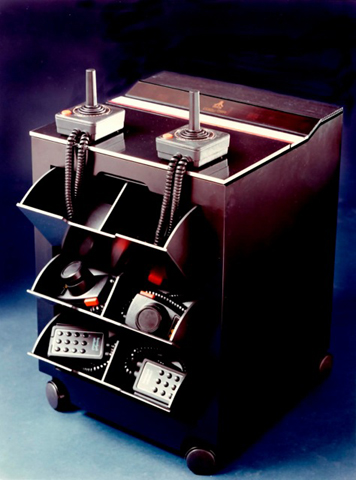
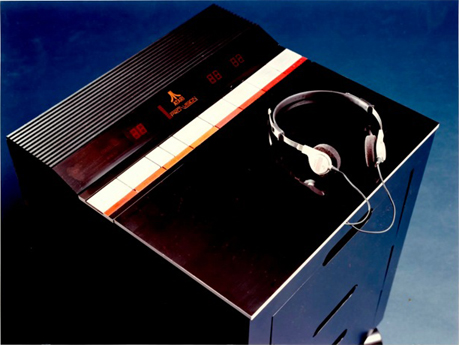
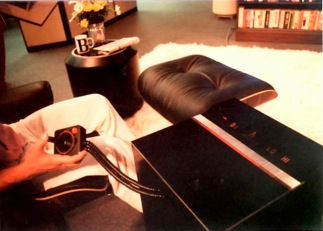
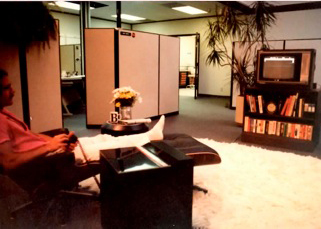
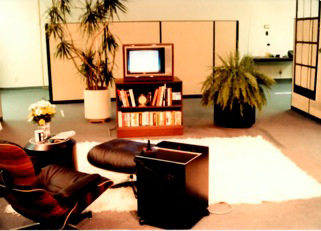
Atari Pro Vision kiosk concept
Here is something different. This was another Atari Advanced Products project. We liked to build things, and we got a request to build a special van that could transport computer systems to classrooms. This was for education outreach to the community and it was critical that it could be easily set up and taken down quickly. Harry Jenkins (pictured) designed and built this project. Each computer system was individually secured to its own case with cover, and the
snazzy custom van was rigged to easily carry it all.
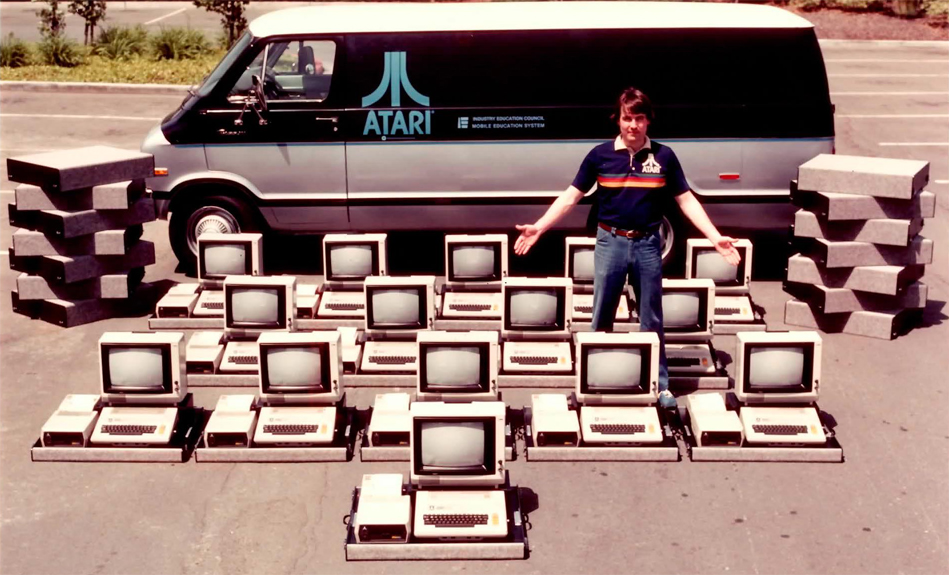
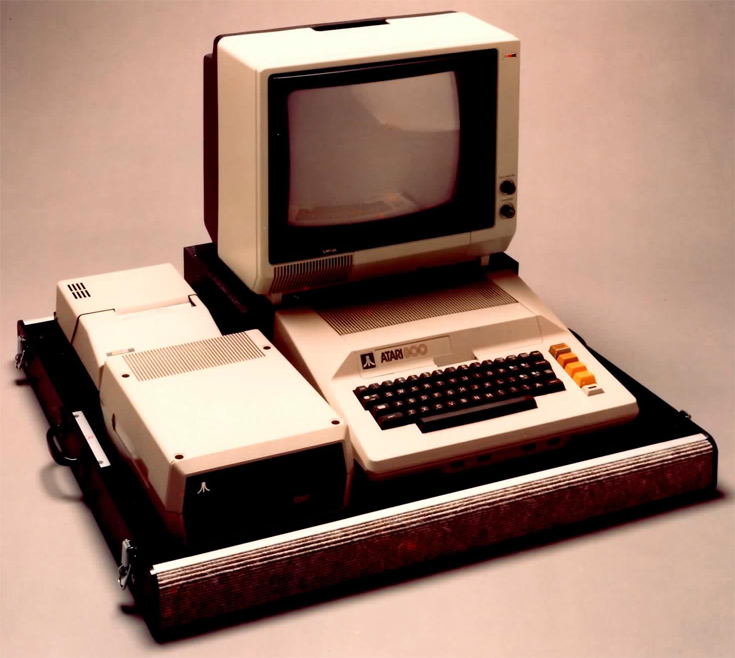
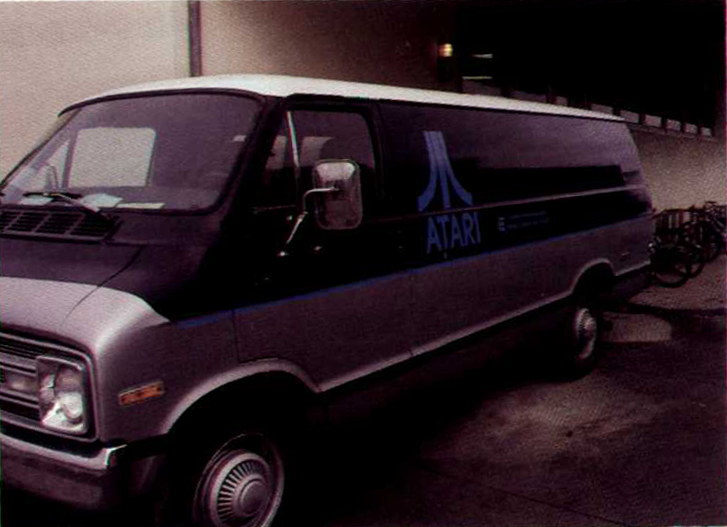
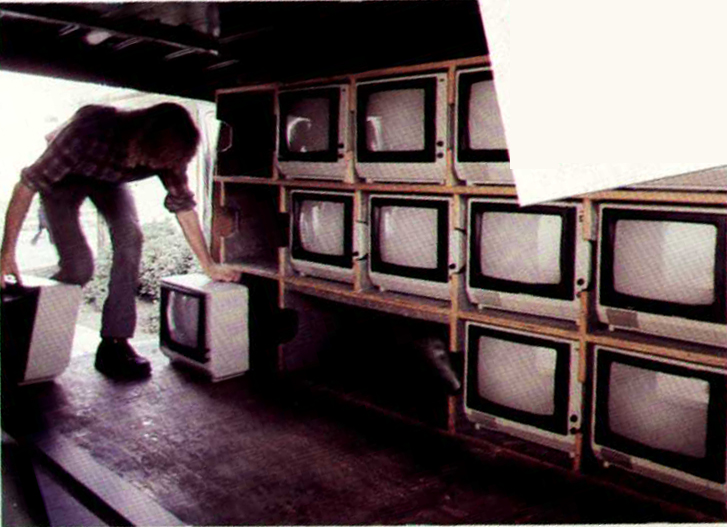
Photos of the Atari IEC (Industry Education Council) Mobile Computer Van
Project. The last two are from an article about the project in the
Spring 1982 issue of
Atari Connection.
We had a couple other handheld concepts going in Advanced Products, as well as other electronic toys and robots. These things seemed to spring up from several places in the company. Between Consumer Products, Coin-op, different creative groups in R&D, and various renegades in the company, there was a lot of development work going on. There was even a handheld device that connected to a phone that had a key pad and LED display with scrolling text typed from the other end of the
call. It was to be a new communication device for deaf people, which was revolutionary at the time. It fully worked, and several prototypes were made (I have one, although I wasn't involved with this project), but it was never produced. At Atari R&D, nothing was off-limits.
Q: As you know, several years after Nolan Bushnell left Atari, he went on to found Androbot, which developed several different types of robots for the home. I’m just curious if this was something Nolan was looking at while still at Atari.
Roger Hector: Nolan was always interested in robots! The Grass Valley R&D group was building robot prototypes that looked like R2D2 and ran around the office. I remember how challenging it was to keep them from falling down the stairs or getting lost. Much of this work was folded into the Chuck E. Cheese animated characters in the restaurants. They were inspired by Disney’s Country Bears attraction. We also played with some ideas for robot toys in Advanced Products.
Q: The Handheld Games Museum notes several different handhelds that Atari was developing. Were there any others?
Roger Hector: Besides Pro Ball (baseball), there was also a football game called Pro Coach. This was considered a "table top" game for two players. Each player entered a "program play" on their private keyboard by selecting the Pass, Run, Kick, etc. button, and then a path sequence to the end zone. Offense and Defense strategy worked very well, and once the play started, you watched the play-field matrix LEDs to see what happened. It was a low-cost electronic game, and was actually a lot of fun to play! Dennis Koble did a great job of programming it and I did the industrial design, but Atari would not commit to moving forward, so it never went past the prototype stage. Too bad.
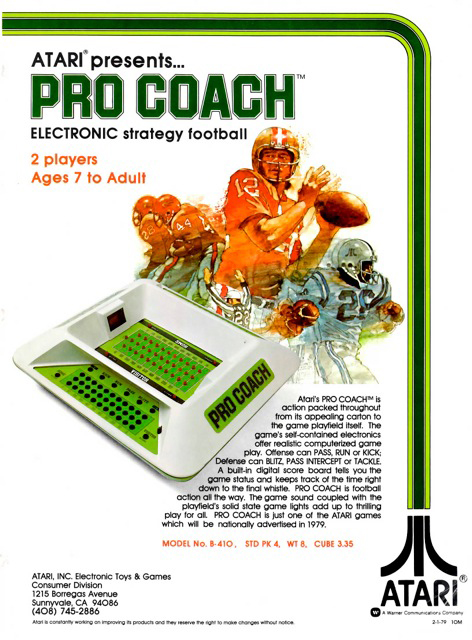
Flyer for unreleased Pro Coach handheld.
We were also assigned the task of going ultra low cost: micro-pocket games with electronic trading cards. Here's some early rough concepts:
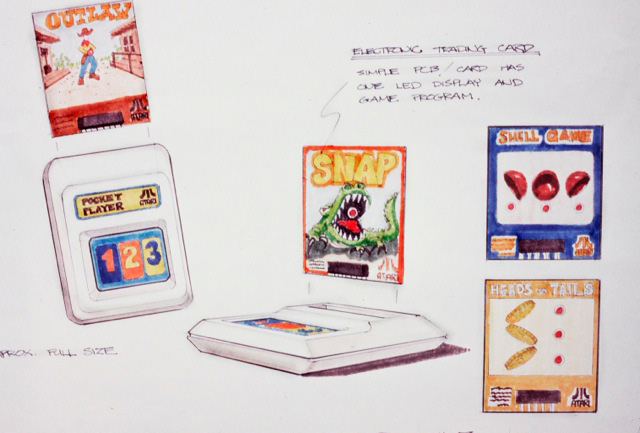
Concept sketch for micro-pocket games.
Q: The Pro Coach flyer seems to hint that Atari planned on creating another division solely for creating handheld games (Electronic Toys & Games). Was that the plan?
Roger Hector: I think the idea was to pull all these handhelds together under one corporate roof at some point, but it never officially happened.
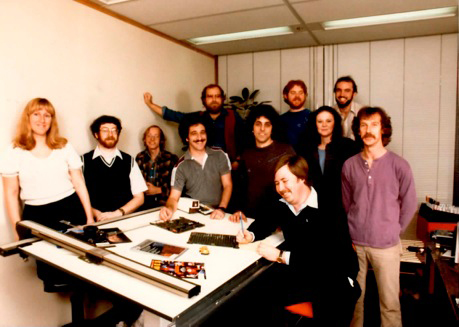
Videa staff circa 1983. This photo appeared in the April 1983 issue of Video Games magazine (pg. 17).
Back row: John Kinsting (programmer), Paul Brandt, (name unknown).
Middle row: Jody Daniels (receptionist), Lee Actor, Chuck Verhaugh, Ed Rotberg, Howie Delman, Dona Bailey, Dave Ross.
Front row: Roger Hector (seated).
Q: What were your duties at Videa, the company you co-founded with Howard Delman and Ed Rotberg?
Roger Hector: I was the President of Videa, but I was also the only artist around, for much of Videa's history, so in addition to negotiating contracts and various administrative stuff, I also did game art and graphics design on everything we did in the early days. We produced 2 VCS carts; Lasercade and Meltdown, and a coin-op game called Gridlee, before we were purchased by Chuck E. Cheese, where we produced the Sente System: a reprogrammable coin-op game system with 20 (or so) coin-op games.
Lasercade and Meltdown were fairly abstract, graphically. I think most of the graphics of these games were created by the programmers. I do remember that Ed Rotberg had a clever idea for anti-aliasing the spheres in Meltdown that gave them a smoother rounder look than could normally be seen on the VCS. Ed was always looking for creative ways to make things better. Both he and Howie deserve huge credit for
making Sente so productive and creative. They also had a good eye for hiring exceptionally talented people.
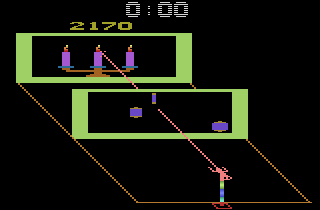
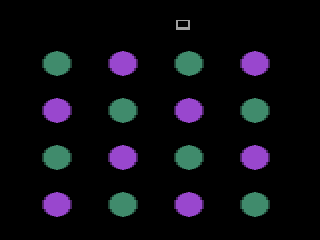
(LEFT) Lasercade; (RIGHT) Meltdown.
Q: In my interview with Lee Actor, he mentioned that Videa sold both Lasercade and Meltdown to 20th Century Fox. Both were shown at the Winter 1983 CES, but were never released by Fox. In my interview with Howard
Delman, he said the games were licensed to 3 different companies (Fox, Parker Bros., and Atari) - none of whom released them. Is that your recollection?
Roger Hector: Yes, it was amazing it happened that way. I had forgotten about the Parker Brothers deal, but now it comes back that we "sold" the games three times... yet they never were produced. The industry overall was in a downward slide, and even though Fox bought the games intending to produce them, they hit the wall and went out of business shortly after buying them. The rights to the games reverted back to us, and we offered them to Parker Brothers, and then Atari, who snapped them up quickly. But by this time, Atari was also starting to hit the same wall and the games just disappeared into the crash at Atari. We were both unlucky (the games were never produced), and lucky (that we sold them at all) at the same time.
Howie is correct that our contract was a License in which the rights automatically reverted back to Videa in the event the Licensee (Fox, and Parker Brothers) failed to perform. The up-front money was a non-refundable Advance against royalties, and we only had to notify them in writing that the license was terminated before we could move on. In the case of Atari, we were dealing directly with Ray Kassar as he knew me (he was my old
boss after Al left). We struck the deal with him, and he signed a simple option contract. Subsequently he authorized the payment to Videa, and a few days later when I came by to pick up the check, I found out that Ray had left Atari! After that it was pretty chaotic there and nobody seemed to know anything about the 2 games that Ray had optioned just before he left. As Atari was collapsing, they had much bigger issues to contend with, and our games fell into a black hole (but
at least we got the check).
I don't remember it clearly, but I'm pretty sure that Cumma's use of the games was informal for the CES show and there was no license involved. We were all friends, and it would be much easier to do it this way.
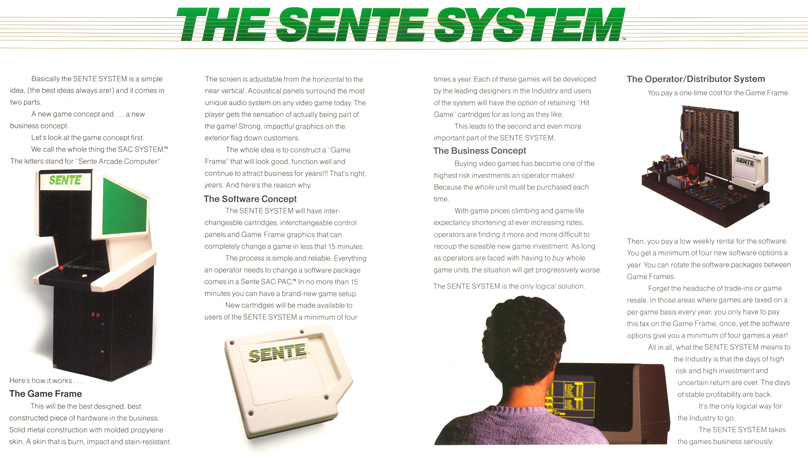
Q: How was being an independent company with Videa compared to being part of Bally (as Sente)?
Roger Hector: Sente conducted creative R&D for parent company Bally. They called us their "idea factory" and my personal plan was to build it for Bally like Imagineering is to Disney. We had great creative talents and technical skills and a burning desire to break new ground. But alas, it was never to be. Bally at that time was a
completely different type of organization than Disney, and the politics were much tougher than we imagined.

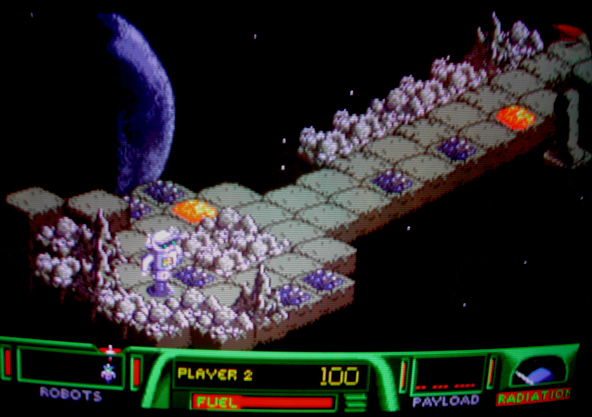
Sente's unreleased game, Moonquake.
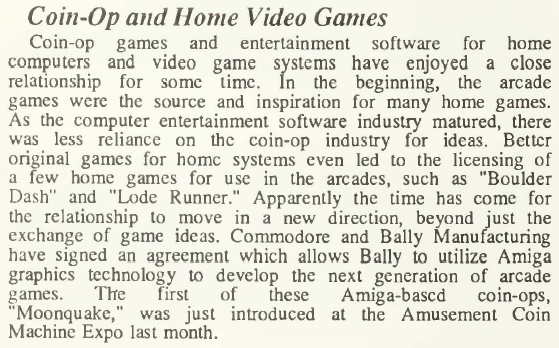
News blurb from the April 1987 (pg. 6) issue of Computer Entertainer.
Q: Do you recall any other games or projects at Sente that you or others worked by that point on that ultimately never got released or even finished? I know of at least one - Moonquake.
Roger Hector: MoonQuake was a robot-in-space themed game that was created/programmed by Bob Smith. Bob is a good guy (and quite a character). I think that was the only game he worked on at Sente. You had to jump (Q*bert-like) through a slowly-scrolling field of floating block-like asteroids, and there were various obstacles and holes in the field to kill you. If you jumped on a block, it cracked; if you returned to that block, it crumbled and it fell through. It was a good basic play mechanic, and looked cool. I don't really remember why it wasn't released. I'm guessing maybe because it was done late in Sente's history. Bally wanted to move us all back to Chicago, and we didn't want to go, so they started planning to close the Sunnyvale office. Development came to a grinding slow-down at that point, and MoonQuake may have gotten caught in that.
Here are a few more photos from Sente's coin-op R&D. This was Sente's prototype version of a crane game that used a robot arm. You had to drop a ping pong ball in each base before the time ran out to win a prize. If you didn't make it, the balls would dramatically launch out and bounce around.
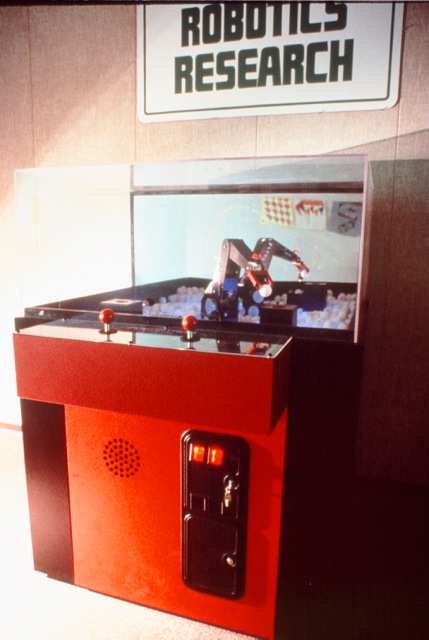
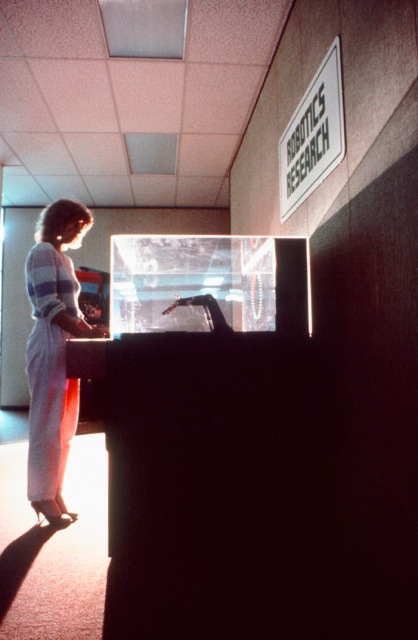
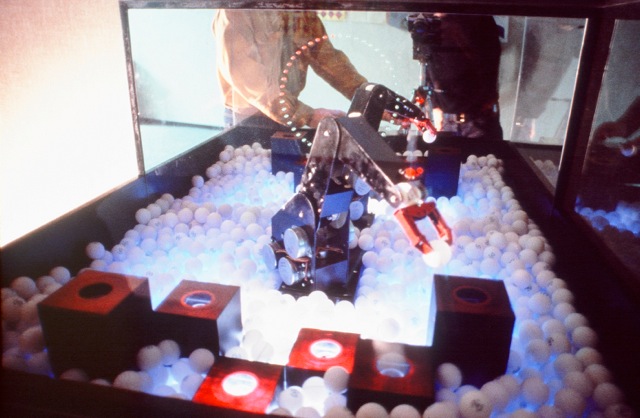
Sente's prototype crane game.
The ones described below - Shrike Avenger, LifeRider, and The Hauntington Hotel - were pretty much the ones that didn’t make it. It was a turbulent time in the games industry and different companies were starting and stopping projects. Many companies went out of business and we were fortunate that we always had projects to do and always kept making payroll. In fact, Videa Inc. (later called Sente Technologies) managed to ride out the low spots and
ultimately was purchased by Bally Corp. where we continued to create coin-op games.
Shrike Avenger was the first game for our motion-simulator coin-op game system, SAC II. It was an ambitious project, and when it worked, it was fantastic, but as you know, the arcade environment is extremely physically demanding. I've spent many hours watching kids play games, and you have to build things to withstand everything from simple, continuous abuse to aggressive, violent attacks. A large, motorized seat+game was a huge attraction (I say target), and you can easily imagine a whole gang of teenagers hanging on it while in play - ouch! It's too bad there wasn't another game produced for this platform. The photos below are of it being produced in the factory:
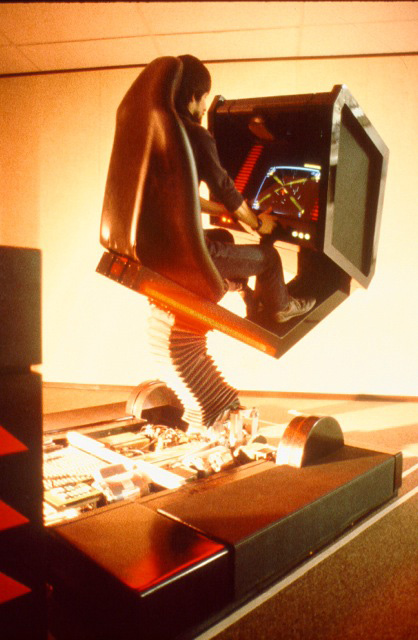
An early prototype of the SAC-II Simulator: Shrike Avenger.
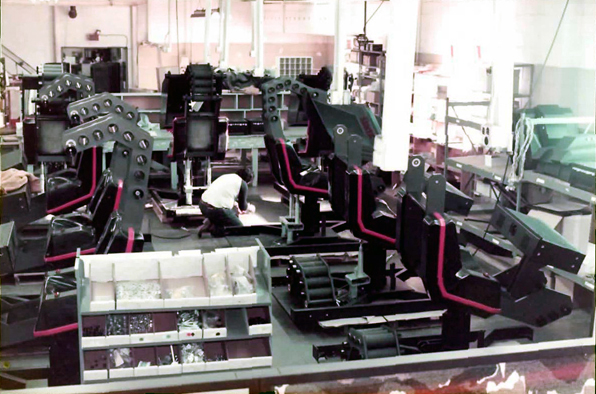
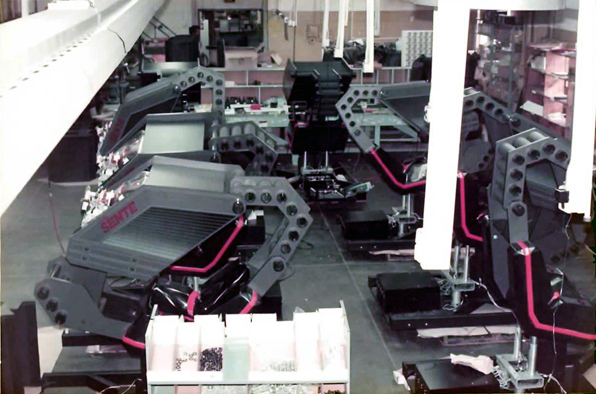
Photos of Shrike Avengers on the factory floor.
Here's some info from Owen Rubin, who was one of the programmers for the Shrike Avengers game:
| "There were two systems in that motion control unit. The regular SAC system which played the game, and a 68000 based motion control computer. The game played like any SAC game, but we may have had extra pages in the ROM cartridge for the graphics. I did not write the software for the motion control computer. My game simply sent commands to that system via a mapped address and that computer moved the simulator. I recall some of the info, but not a lot. We had several methods on that machine to keep the simulator from running off the end. The simulator was two "ball screws" on one end driven by stepper motors and a "u-joint" JUST like the one you would find in a Corvette for the game cabinet to pivot about. I could drive each screw up and down independently to achieve the motion I wanted. Not exactly 3D motion, but I got some good effects. The motion computer would initialize the box by first slowly testing the limits of the motion. We had 2 switches on each end of each actuator. The design was to stop the motion of the first switch closed, and reverse the motion if the second switch closed, meaning you ran too far past the first switch. To test the limits, we would move the actuators to the low limit until it hit the first switch and stop. We would then slowly move to the other limit, counting the number of steps to the motors needed to hit the limit switch on the "up" end. The software would use these counts to never ask the simulator to go beyond these positions. If I recall, my software in the SAC let me know control the simulator by requesting a "numbered" position from 0 (all the way down) to "n", all the way up for each actuator. The idea was that we would never run one of the motion actuators off the end, thus dumping the game cabinet on the floor (sad news was that when it was first worked on before I started my work on it, that actually happened EVEN with all these protections. The damn thing moved fast and even the auto reverse was not fast enough to stop it from going over once. We later added steel cables as well JUST in case it happened again, which it did not.). The two actuators were in the back in the left and right, with a U-joint in the front. If I moved the two actuators at the same time, the cabinet rocked forward and backward, basically pitch. If I went up on 'l' and down on 'r,' then the cabinet essentially went "roll" right, with an obvious backward pitch since the rotation point was always around the u-joint in the front. The opposite direction "rolled" left. Marketing could call them what they wanted, and we got some very cool motions by playing with the timing of the motors, including a circular motion which felt like yaw. It was WAY too expensive for the day, I think around $10k. For that time, that was VERY costly. The other problem was that it was expensive to build, move, and ship. Lastly, it was VERY costly to maintain. With all those moving parts, it broke a lot. I am sure the closure of Sente was part of the issue, but Bally continued and if successful, it could have been made there. I was asked about two years later by one of Bally's customers in Italy to build another game for the simulator. Had I still had access to the source and development environment, I would have, but alas, that never happened. In reality, the Shrike Avenger program was never finished either. The game was started by Jim Turner, who left Bally Sente. The game was not very far along, and I was only given about 6 weeks to turn it into something. The graphics were done, and I had to make something work. I chose to model the game after The Last Starfighter actually, but never got to finish it. The game was to be a practice round shooting at small targets, then a long round of shooting at attacking ship (the game you play now) and then you were going to have to go against the "mother ship" and shoot out 4 engines and then the target array to win the round. Given the time, I tried to do something fun, but the actual play never really developed. There was going to be a "death blossom" shot you could use once that would have been a wild ride as well, but that motion was VERY tough in the simulator, so I did not complete it. |
LifeRider was the first adaptation of a video game into a piece of exercise equipment (a stationary bike). It was done for another division of Bally: LifeCycle (later called Life Fitness). The game screen was mounted on the bike and was a top-down view of a bike on a road. The rider had to dodge around traffic and keep pace with the selected ride routine by peddling. It was another groundbreaking idea that fell prey to corporate politics and suffered the same fate as
the dark ride. But numerous companies have picked up this ball and have successfully run with it since. I don't think there is any chance of finding the LifeRider code, though. I'm sure it is long gone...
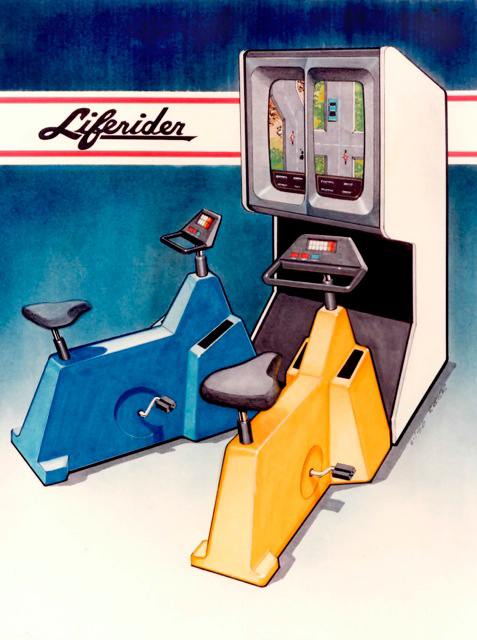
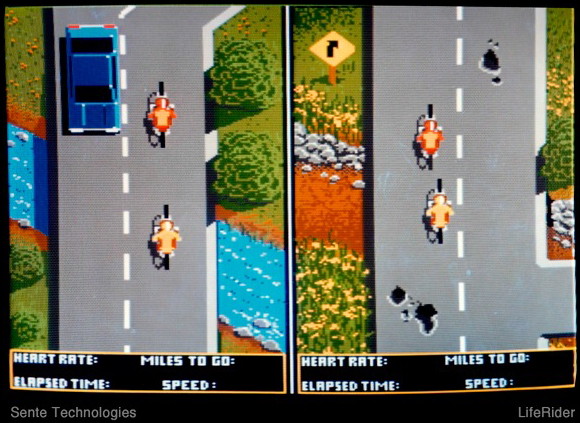
LifeRider concept drawing and actual screenshot
The Hauntington Hotel was a complete design for a Ghostbusters-themed dark ride that was produced for Six Flags (another division of Bally). It was another "first" of its kind as it was the first interactive theme park game/ride, giving its riders a ghost busting gun mounted in front of them, and a variety of sophisticated "ghost" targets to shoot at, and receive a score and prizes. In this way, it was a huge game that required many plays to learn and master. The target
ghosts were a combination of physical animated props with CG displays that were combined through mirrors, and they reacted/exploded when hit. The guns were a combination of laser pointer and IR emitter that kept track of hits and displayed the player's score. The whole thing was created, designed, engineered, and prototyped at Sente, and the ride system was in the hands of a prominent roller coaster engineering company, Intamin. But before it could be rolled out in the Six
Flags parks (1st one was slated for Texas), Bally sold the Six Flags division in 1987, and the project fell into a corporate black hole, never to be seen again, which is too bad, as it was really pretty cool, even by today's standards. I hadn't seen anything like it until 20 years later when Disney installed the Toy Story Midway Mania ride at Disneyland in 2008. I don't think any of it has ever been seen before outside the company. We had a very strong concept & storyboard
artist named Don Carson, and below is some of his work, along with some of my sketches. This is far from complete, but it's all I could find. The photos below only show some of the many scenes & features. Howie and his team prototyped the technology, and the layouts and sets were all there. At least you can get an idea for it.
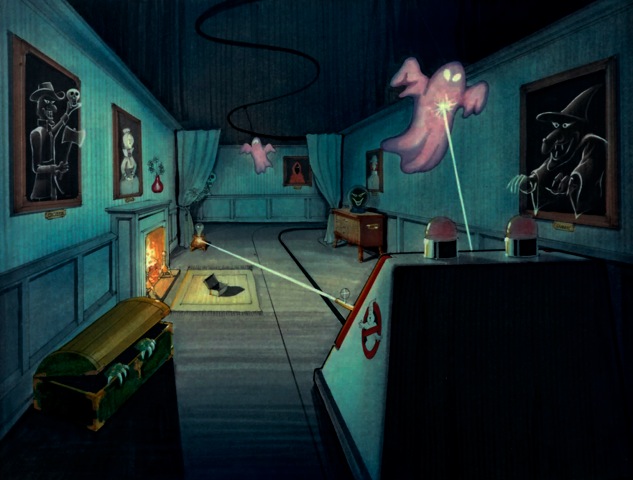
Concept sketch
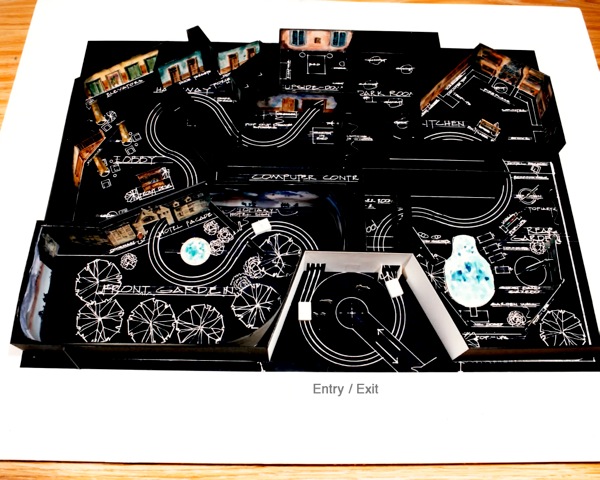
Ride layout. The story maps to this overhead model.
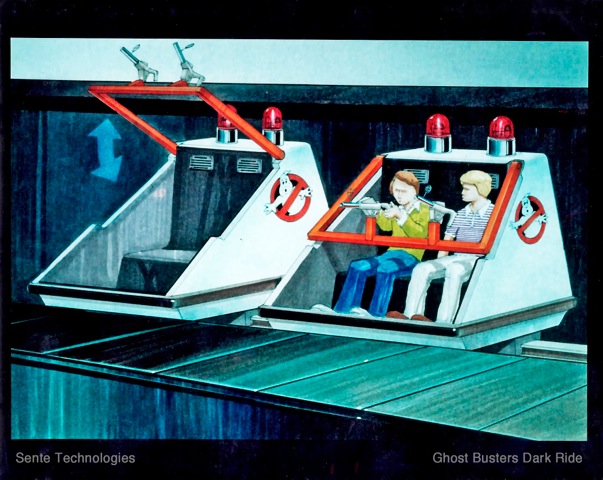
This was an early development sketch. Players climbed into a "Ghostmobile" at the beginning of the ride and a bar dropped down with ghost busting guns mounted on it.
After boarding the Ghostbuster car, the players are told they have been recruited by the Ghostbusters Agency, and they are headed for their first job.
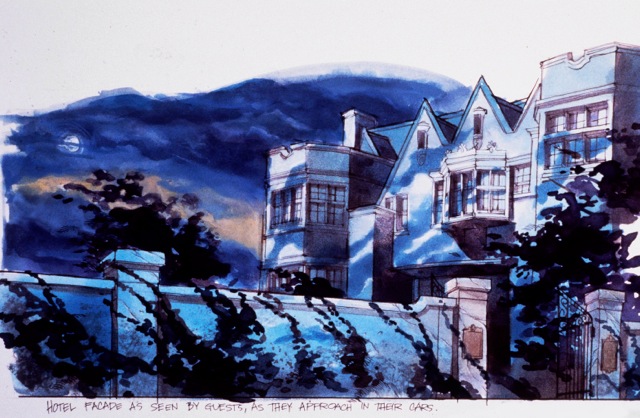
They first approached the outside of the creepy hotel...
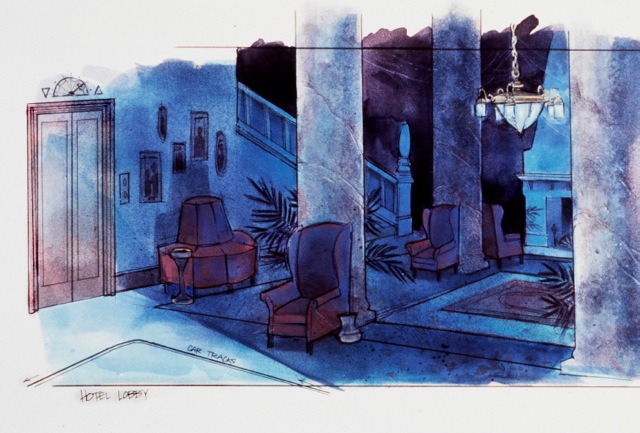
...through the front door...they then enter the lobby...
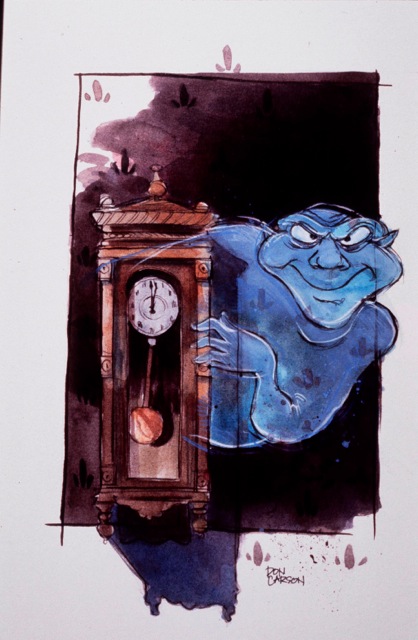
...to discover the hotel has a ghost infestation!
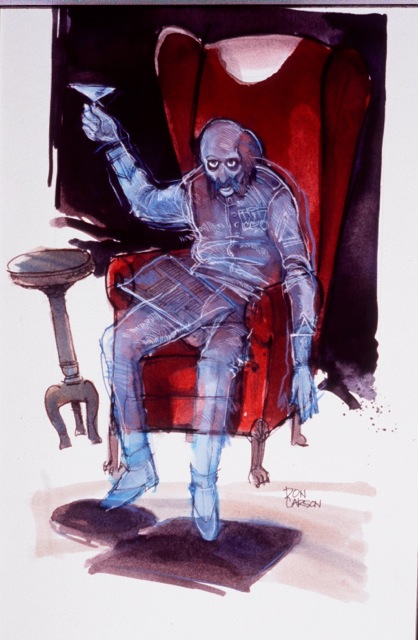
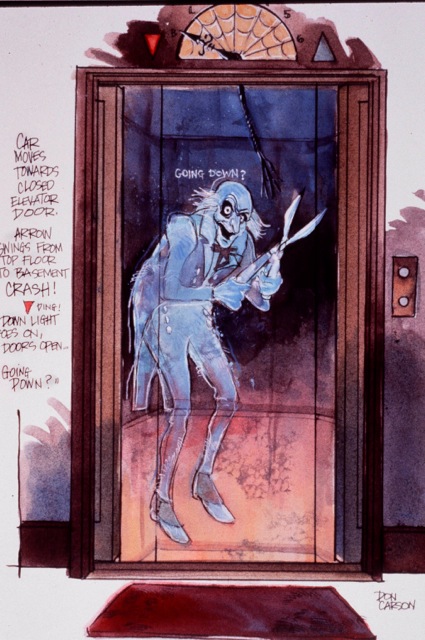
Your goal is to shoot all the ghosts for a high score...
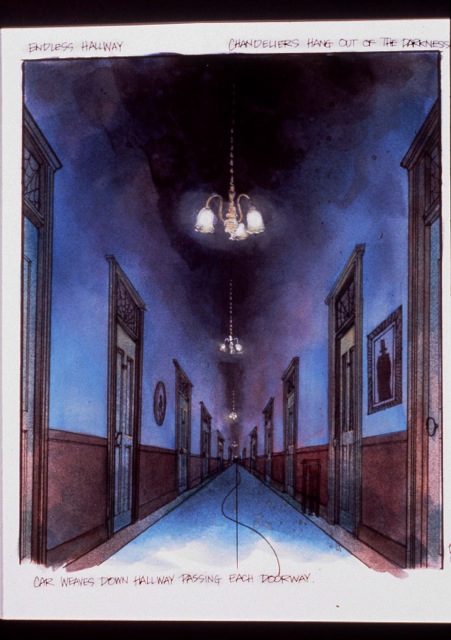
Down the dark hallway...
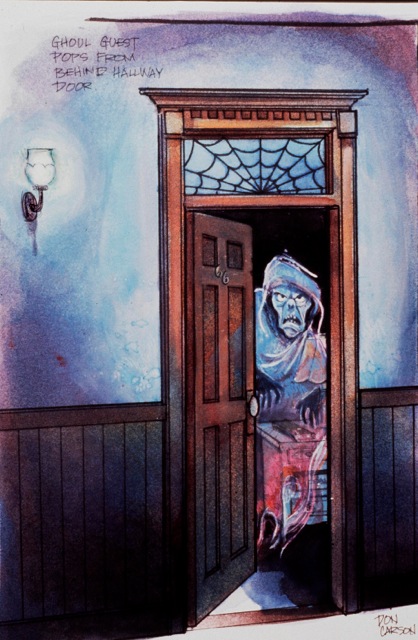
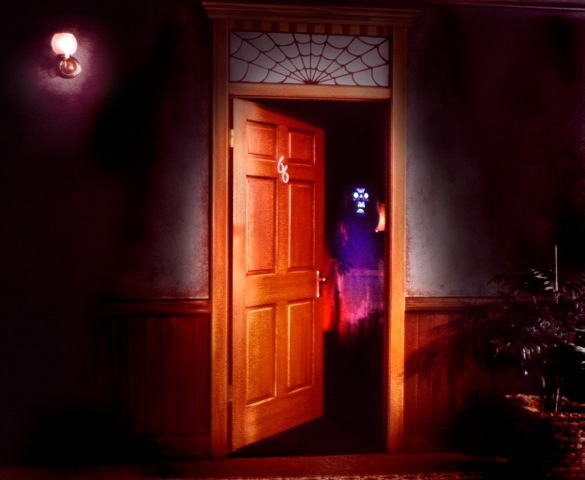
...past several haunted hotel rooms... (LEFT) Artist concept; (RIGHT) Real mock-up scene in the Sente office.
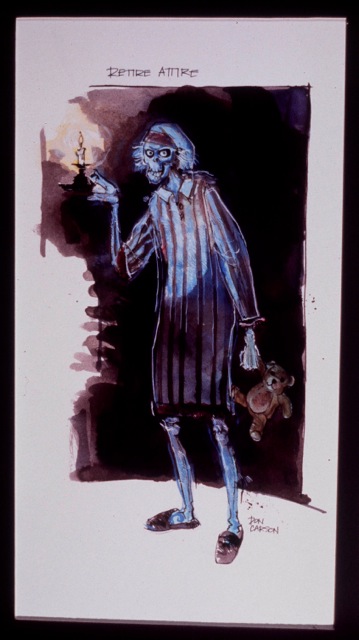
...more ghosts...
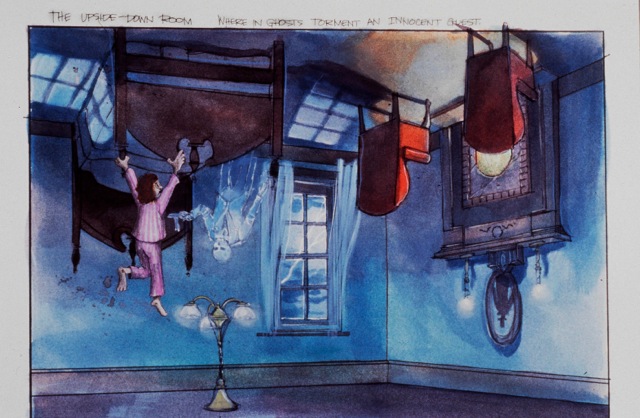
...through the Upside Down room...
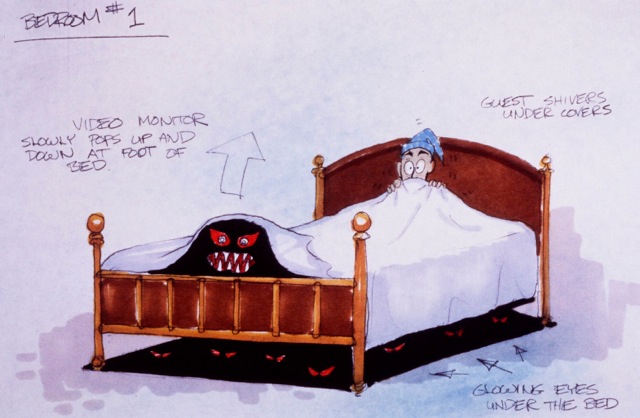
...more ghost targets to hit...
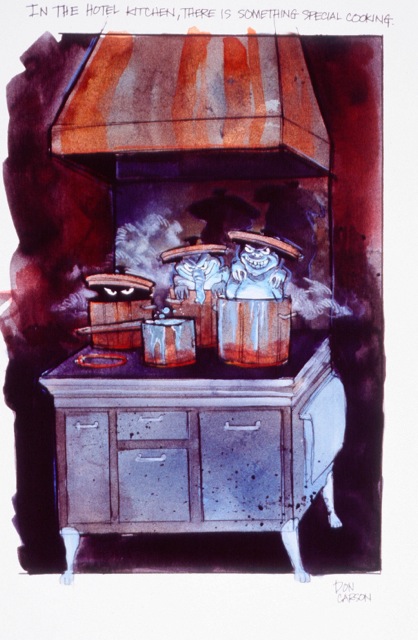
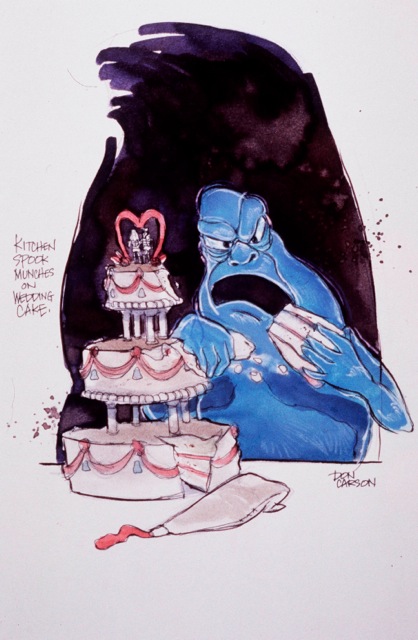
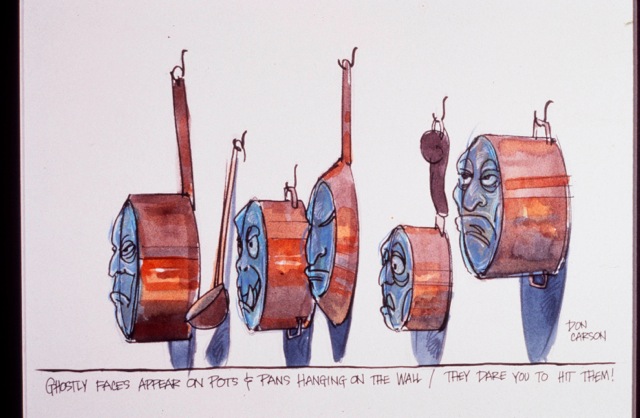
...through the kitchen...
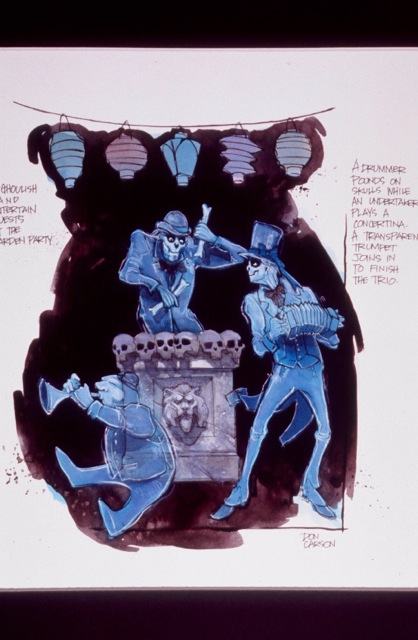
...and out the back door into the garden...
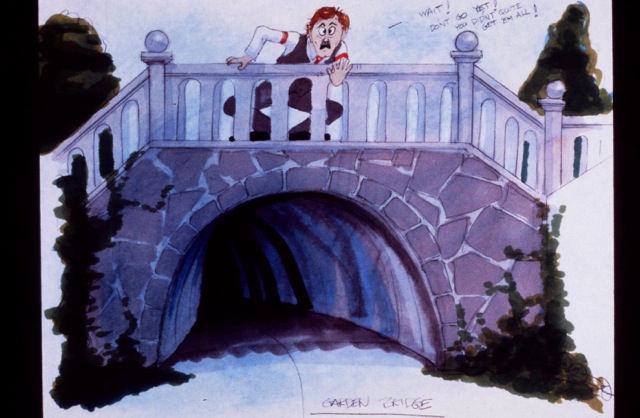
...and under the bridge into darkness...
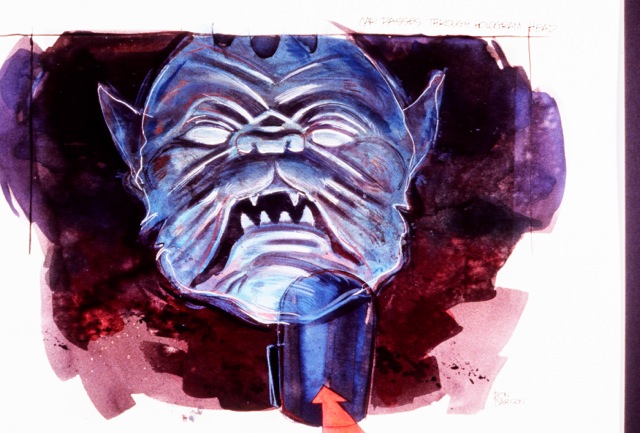
...for the big BOOOO finale!
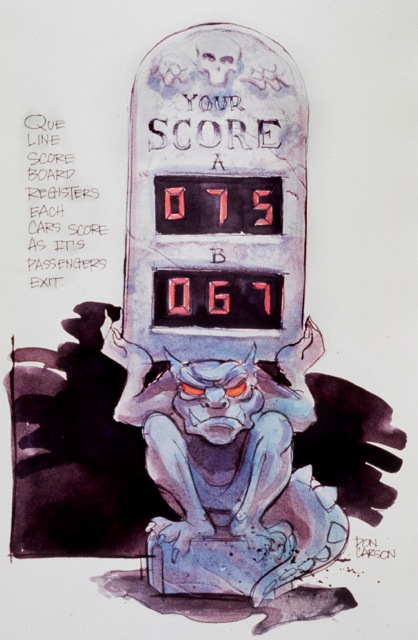
And you get your score on the way out.
The ride was designed to run for about 2.5 minutes from beginning to end, and used a variety of high-tech and low-tech gags for the scenes. Every target would react to being hit so the player could easily know when they got 'em. I've never seen any of this outside of Bally / Sente.
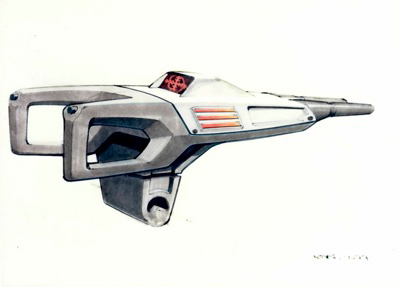
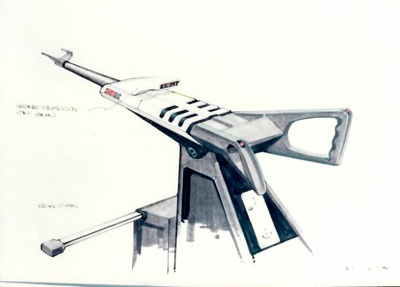
Gun sketches
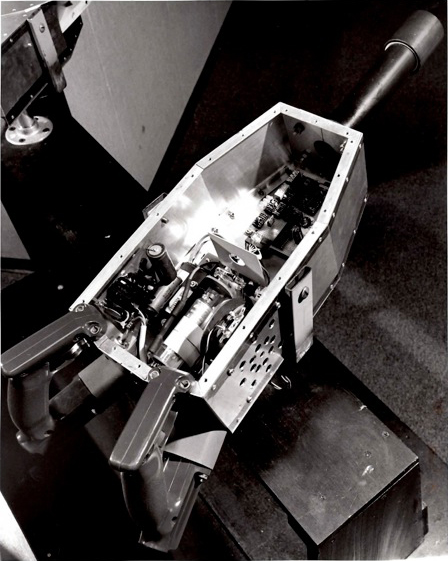
Prototype gun exposed
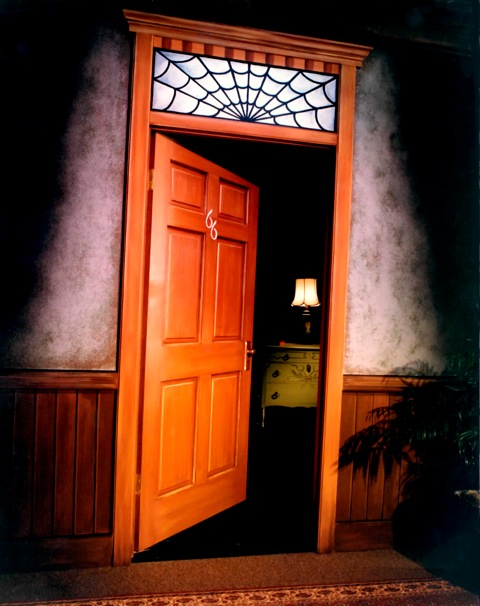
Full size prototype hotel room. Door creaks open.
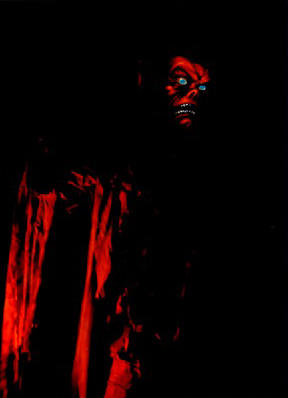
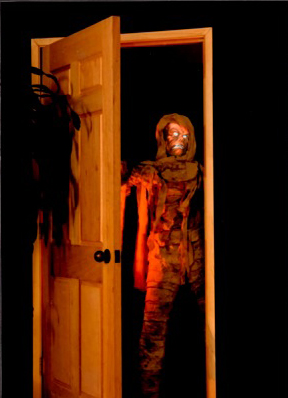
(LEFT) Mummy ghost with animated CG monitor in head; (RIGHT) Lighting turned up to show scene construction.
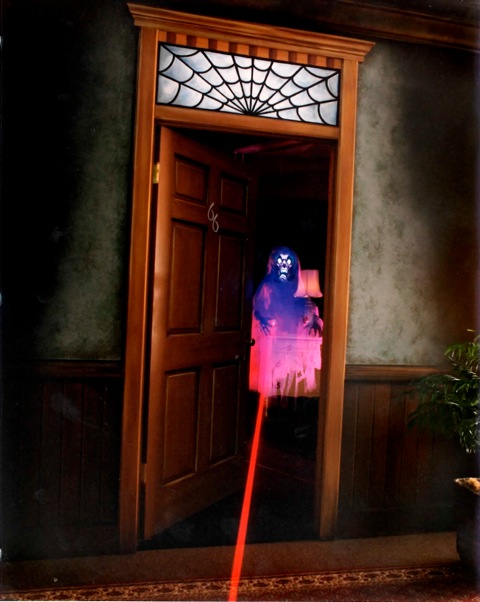
CG ghost materializes in doorway via angled mirror, and player shoots.
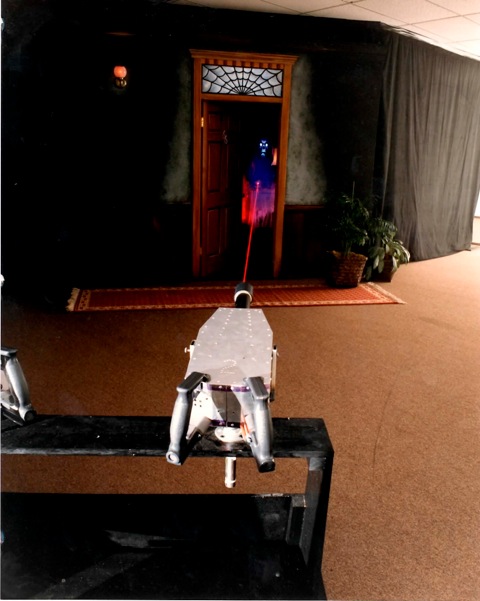
Pull back: Prototype stage in the Sente office with working gun mounted on mock-up rolling car.
We pushed it around the office to simulate the ride.
Q: Were there any other scenes mocked up besides the hallway doors one?
Roger Hector: We built up the hallway ghost in our office to test the guns and supporting control systems. The others were designed and were waiting for the green light from corporate. Instead of the green light, we were told to hold off as Six Flags was being sold. Intemin had taken the ride system pretty far as well, so this disappointed us all. That's show biz...
Q: I love haunted houses, and even helped build and run several locally, so I immediately recognized the use of a Pepper's Ghost there.
Roger Hector: Yes ,we used Pepper's Ghost to make a ghost materialize and disappear. The Mummy Ghost had a full-size body draped in fabric (animated by a fan), and a CRT head with full CG animation. It would growl, roar, react when hit, and then disappear… all in a few seconds. There were also many simple physical shooting gallery-style gags (flying props with mirrored video effects), and other ghost monsters. It would still be amazing to do this today, and our newer tech could do a better job (Ed.: Howard Delman wanted to add, "For ease of prototyping, all of the video effects were running on Sente SAC-I PCBs.").
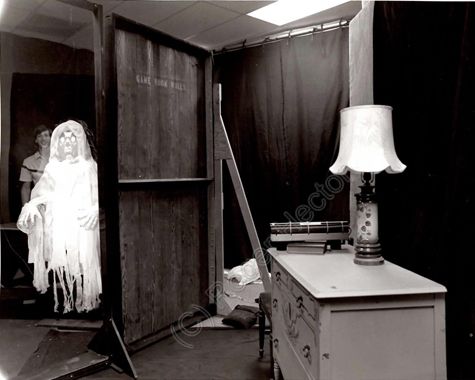
Our tech, Pete Mokrus, behind the scenes, tweaking the Pepper's Ghost.
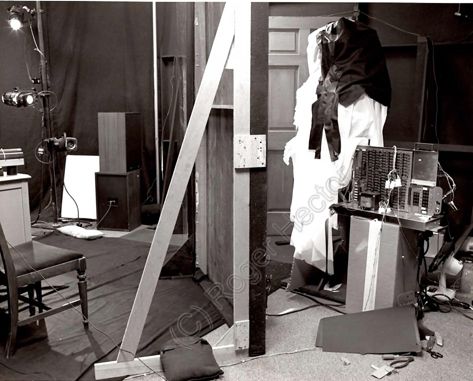
More Backstage. That is the Sente hardware Howie mentioned driving the ghost.
Q: Being a fan of Disney's Haunted Mansion attraction, I can really see the H.M.'s influence in some of these.
Roger Hector: I too have been a long-term Disney fan. Don Carson and I both loved Disney's Haunted Mansion, and we wanted to build something more engaging. Theirs is a passive "show", and we wanted a "game". You can have a Disney influence with a blend of humor and story theme. But at Sente, we wanted to bump up the player involvement with interactive CG effects. I guess you can say the H.M. was inspirational as it was the state of the art, and I studied every inch of it.
As an aside; I've spent a fair amount of time at Disneyland as a guest, and later as a Disney employee. I remember one day, while with Sente, being at Disneyland taking notes on a clipboard as I studied the rides (ride capacity, ride times, queue line waits, etc.). Other guests thought I worked there and asked me questions about where to find things in the park. I politely answered them without hesitation. Little did I know that I
would later officially work at Disneyland and give directions...
Years later, as a member of Disney Software management, I was occasionally asked to volunteer to "work at the park" for a special event. They would close Disneyland for a private event like Elizabeth Taylor's birthday party, or a military families night. The regular Disneyland cast would go home, and the "volunteer" management would come in to run the park for the event. I got checked out to operate Star Tours (which I did several times) and it was always fun! I
also remember taking a company management-training course that had me actually put on a character costume (Eore the donkey) and walk around the park interacting with the guests. I enjoyed my experience at Disney as much as any other company in my career - good times!
Q: There was an interview you did for Joystik magazine (July 1983, pg 10-11) where you mentioned, “Sente knows more about holography than anyone else in the industry.” What plans did Sente have to incorporate holography with games, and how far along did development with that get?
Roger Hector: The first Sente project that used holography was the Hauntington Hotel. We used some holograms mounted in picture frames to change portrait paintings on the walls into 3-D ghost portraits. We built this and showed it to Six Flags who loved it. But we never got to take this further when the dark ride stalled. I would have loved to continue with the Atari holography product ideas, but Sente never had the budget for it.
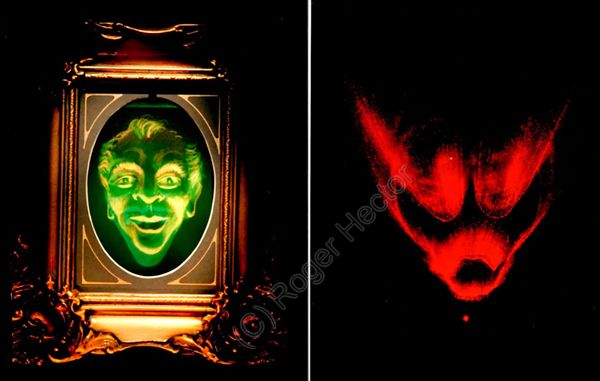
(LEFT) Wall portrait with stage 1 image hologram (hard to see, sorry).
(RIGHT) Animated pure laser projection of a face (also very hard to photograph). Had blinking eyes and talking mouth.
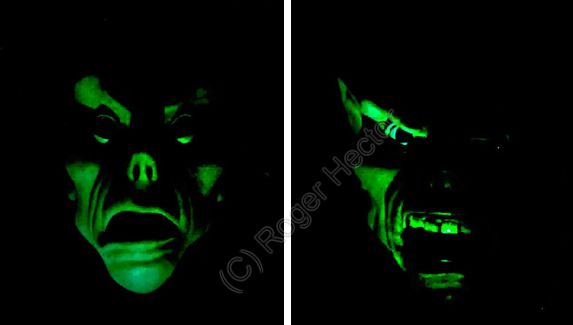
(LEFT) Stage 2 portrait hologram (menacing); (RIGHT) Stage 3 portrait hologram (scary reaction to being hit)
These faces were sculpted in clay and were superimposed over each other on top of the wall picture.
Q: Where did you go after Sente?
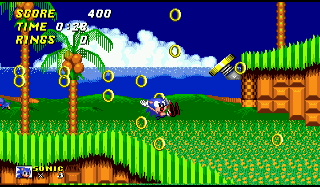 Roger Hector: I went to Electronic Arts, where I was Executive Producer in charge of all Arcade/Action/Sports games. I was involved
with creating game franchises many years ago that are still going today such as John Madden Football and PGA Tour Golf.
Roger Hector: I went to Electronic Arts, where I was Executive Producer in charge of all Arcade/Action/Sports games. I was involved
with creating game franchises many years ago that are still going today such as John Madden Football and PGA Tour Golf.
In addition to those companies, I was also the Director of Product Development for Walt Disney Software (now called: Disney Interactive) for several years where I produced numerous PC games and licensed cartridge games. I also worked with Imagineering on large-scale interactive attractions. Later, I was the VP of the Sega Technical Institute during Sega’s heyday where I managed the development team for the Sonic the Hedgehog series as
well as other new titles like Comix Zone, and even coin-op games like Die Hard Arcade. From there I was asked to join Universal Studios to help establish a division for game development, which became Universal Studios Digital Arts.
After working at Universal, I wanted to take a break and try something different for a while. I worked with a small start-up that was bringing new technology high-definition digital theaters to the e-commerce business. For fun, and I also started a company that designed and manufactured a real limited production sports car! I’ve been an artist for many years, and you can see the car along with my car artwork at:
www.rogerhector.com.
This was all interesting and fun, but when Namco Bandai approached me to come back and head up game development, I was very excited by the opportunity and made the jump. My position with Namco Bandai Games America was SVP of Product Development.
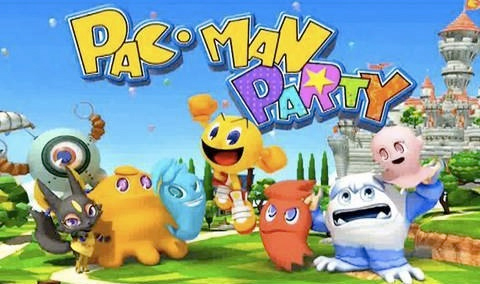 Q: How long were you at Namco Bandai
Games?
Q: How long were you at Namco Bandai
Games?
Roger Hector: I was there for almost 3 years. Namco Bandai was looking to reorganize and upgrade its development organization. I was responsible for all North American game development for the company. This included both internal teams and external contracted development, as well as collaborating with Namco Bandai Japan on new projects that were in development there. Game titles already in development included Afro Samurai, Dead to Rights, and Splatterhouse. I helped get them out the door, and added Enslaved on PS3/360 (I loved this game!), and I even helped re-design the Pac-Man character for his modern style in Pac-Man Party (Wii), which was developed internally across both the USA and Japan. It was an amazing time with many talented people which are still good friends. Good memories!
Q: What were some of your other experiences working in the game industry?
Roger Hector: After 30+ years, I could write a whole book on my career developing games. Each company was a unique place, with its own crazy personalities and challenges. The big, successful games were, of course, exciting and rewarding, but it has also been a great deal of fun pioneering with new technology. In the early days, so much of what we did was pure invention. There were no established "rules" for doing things, so we did whatever we had to, to make things work. When Ed Rotberg was working on a new vector-graphic coin-op game (Battlezone), he asked me to design some 3-D tanks and space ship graphics for it. But there was a small problem. I think this was the first 3-D game, and we had no tools for designing 3-D graphics that Ed could input into code. So we worked together and I used a process called "lofting" to design graphics that assigned vector points in space and I gave it to him on graph paper. This process goes back hundreds of years to the days of wooden ship building, but it came in handy for a first application of new game technology.
Also, it's been fun breaking into successful new markets including Disney’s preschool software series, and the Sente System’s idea of cartridge-reprogrammable coin-op games.
We’ve launched numerous platforms and I’ve released over 100 games (can’t remember them all) that have produced over $2 billion in revenue.
Overall, I’ve been quite fortunate to have all these fun and rewarding experiences, and to work with such a crazy, magnificently talented bunch of people! That has been the BEST part! Knowing that many millions of people all over the world have had fun playing these games is icing on the cake.
Q: I usually ask people if they ever put any Easter eggs in any of their games, but did you ever sign any of your artwork?
Roger Hector: What started as a simple (hidden) way for a programmer to get his name in the game (sign his work), evolved into the whole practice of hiding different game play features and hidden levels for the players to find. This became a giant feature that players now love and expect. I signed many of my design concept sketches, which became part of the process of tracking projects by inventor for subsequent patenting, but I never snuck in an Easter egg signature anywhere (that I can remember, anyway).
Graphic artists were often left out of credits in the early days. Although, it was common to have an art project divided between several artists based on their special expertise.
For example, I was asked to design some "space age motorcycles" for the Space Riders pinball backglass, so I sketched some that were later integrated into the final art. The figures and overall composition was done by someone else (don't remember who). We had great cartoon character artists like Bob Flemate, and excellent illustrators like Steve Hendricks. We had a deep bench of talent including Jim Kelly, Evelyn Lim, Jim Arita, and others. Even George Opperman (the boss) was a solid artist and a great art director. These guys worked every bit as hard and passionately as the engineers, and were commonly left out of the credits. But the times have changed, and at least now everyone gets acknowledged - sometimes it's a cast of hundreds!
Q: Did you ever attend any industry shows, such as CES or Toy Fair?
Roger Hector: I always attended the CES show, the AMOA (coin-op) show, and occasionally Toy Fair. I even wound up designing some show booths, signs, and displays for the games we were presenting there. The CES was always the biggest show, and I remember the late 1970’s were amazing, as there were a lot of very new technologies being presented like laserdiscs, VCRs, even
microwave ovens! Pretty cool stuff at that time.
Here's a photo of an AMOA trade show booth I designed. The modular snake sections plugged together in many configurations for different shows and had fun neon signs:
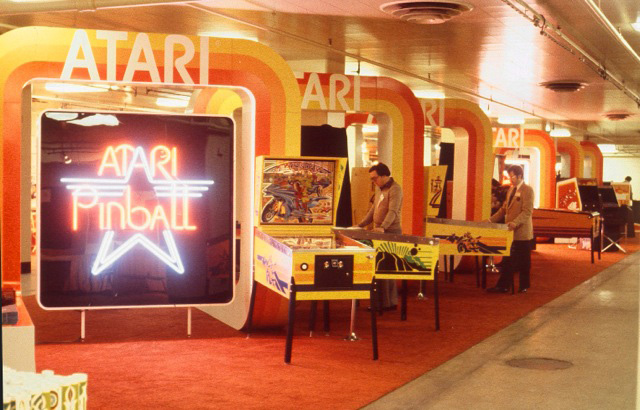
Q: Do you still own any of your games for these systems, either as a keepsake, or to show friends or family?
Roger Hector: I’ve tried to keep a sampling of the old games, and I have a few dusty boxes in the attic that I haven’t looked at in years. Someday I expect to pull them out and relive the “old days”... but I’m not quite ready for this yet. I used to have a bunch of my coin-op games in my game room, but I’ve actually given them away through the years (they do take up a lot of room), which was probably a bad idea.
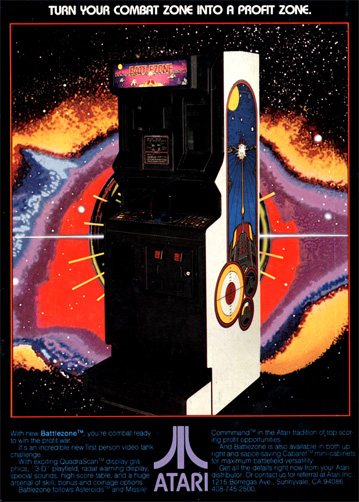 Q: Which of your titles are your favorite, and what types of games in general?
Q: Which of your titles are your favorite, and what types of games in general?
Roger Hector: It’s hard to remember them all, but certainly the Sonic series was a real favorite of mine. I also loved Comix Zone (Sega), Battlezone (Atari), Jordan vs. Bird: One on One (EA), and Enslaved (Namco Bandai). I generally like action/arcade/adventures games, and I am a pretty good player (when I get some time to practice).
Q: What are your thoughts on remakes of games? Using Warlords as an example, I was hooked on a great version of Warlords for the Amiga called Lords of War. There have been a few other remakes since - the latest being for the XBOX and PS3, but most remakes are more about "eye candy" and less about the gameplay.
Roger Hector: I like Lords of War. It looks well-made and has several clever additions to Warlords without losing the original playability. Looks like fun. I agree with you on the modern remakes. The Warlords on PS3 especially looks like the beautiful production (nice characters, effects, animations, and play features) completely overwhelms the basic gameplay and the whole thing falls down.
Q: Have you stayed in touch with any of your former co-workers?
Roger Hector: I try to touch base with friends and keep track of old colleagues, most of whom are from the development community like: Al Alcorn, Howie Delman, Dennis Koble, Lee Actor, Rich Hilleman (EA), Hirokazu Yasahara (Nintendo), Mark Cerny (Sony), Peter Morawiec (Isopod Labs), etc. I've had the pleasure of working with, and learning from, many of the top industry execs and legends like: Nolan Bushnell and Al Alcorn (Atari), Trip Hawkins (EA), Tom Kalinski and Shinobu Toyoda (Sega), Shelley Miles (Disney), Makoto Iwai (Namco Bandai), as well as working with great biz dev guys like: Riley Russel (Sony), and Zack Karlsson (Capcom), and many many more. This list can go on and on...
Q: What are your thoughts on how the industry has evolved?
Roger Hector: When first I started, programming was expressed on punch card tape. Game art was drawn by filling in squares on graph paper with pencils. Sounds were selected from a very limited group of “beeps.” But still… the games of the time were wildly new and entertaining. They sparked tremendous engagement and enthusiasm, just like today. The technology and processes have expanded (as well as the
budgets!!!), but the end goal is exactly the same today. We seek to entertain someone’s brain while engaging their physical body. That’s what separates us from passive entertainment like movies & TV. It’s all about blending technology & innovation with novelty and that certain creative spark to build a fun interactive experience. In this way, little has changed.
But on the other hand, the rate of change has been accelerating. The rapid evolution towards mobile devices, freemium and social network-based business models, self-publishing, and crowd-based funding has rapidly moved the targets again. The market share of traditional consoles & retail & promotion has declined, while the value of microtransactions and “discoverability” online has skyrocketed in importance. Development budgets span a larger range from $10s of thousands (for
self-published games) to $10s of millions (for the established franchises). Self-publishing was not possible or practical before, but today a talented individual with no money can get funded through Kickstarter, and produce and publish their own game online. That’s amazing!
The Casual games of today are similar in scope to the high-end games of the 70s & 80s. Today’s high-end games are staggeringly complex and expensive to produce, and with a bigger development budget at risk, they tend to feature “safe” formula gameplay and fancy production value over creativity. But these are the same basic economics of the general entertainment industry, so nothing has really changed there. The challenge still boils down to identifying your specific target audience and providing solid entertainment with the right mix of familiarity, novelty, and focused target delivery. And as always... the hits drive the business.
Sure there are still lots of problems; from network security, to international platform chaos, to evolving customer segmentation and tastes. But the show must go on! Personally, I think it’s a very exciting time in games right now. There are more opportunities for real creative innovation through a constant stream of new technology. And there are many more people making and playing games today globally than ever before. Like any art form, the best will rise to the top... and that can only lead to fun times ahead!
Q: Are you working anywhere now?
Roger Hector: I left Namco Bandai over a year ago, and have been working with my old buddy Al Alcorn on a potential (secret) game start up. No information available about it yet, but we may have something cool in the mobile space. Stay tuned...
Q: About a year ago, several former Atari alumni of yours started up a new company founded by Seamus Blackley called Innovative Leisure, who were working with game developer THQ to develop games for mobile platforms. A few months later, THQ announced it was canceling their publishing plans for mobile games, but that Blackley were going ahead with help from venture capital firm Hummer Winblad (article). In 2011, Rovio (makers of Angry Birds) rebuffed an acquisition offer by Zynga (makers of FarmVille); last year, both companies have seen drastic drops with their stock prices. Is what’s happening in that market now simply another shakeout? I can’t foresee another “crash” akin to the one that hit the industry back in the early 1980s, as the popularity of mobile devices seems to be going nowhere but up. But new technologies on the horizon could supplant that, such as Google's Glass or Apple's iWatch. What are your thoughts on Innovative Leisure, and the mobile gaming market in general?
Roger Hector: I’m not up to speed on Innovative Leisure's latest news, but I know they’ve tackled a big job. It is a clever concept to leverage the seasoned old veteran’s experience across younger talent. And this is a very talented group! These guys are all old friends and colleagues of mine, I respect them all highly, and wish them the very best of luck!
I also don't see a pending crash in games like happened in the early 80's. At that time, it was such a complete devastation in consumer games that the only refuge was in coin-op for a while. Everyone thought Nintendo was crazy to go back into the consumer console business, but I've always believed that Nintendo should NEVER be counted out. They are the quintessential game company that has had gaming at their very core throughout their whole history. Whatever happens, their culture, talent, and determination will always make them my favorite for 'Last One Standing'.
Having said that, everything is (once again) up in the air right now, and I do think we are in a bubble. Times are rapidly changing. Companies will rise and fall as consumers are bombarded with lots of new platforms, online distribution, and business models from mobile, tablets, toys, networks, freemium, subscriptions, etc, etc. Rovio and Zynga, and others have successfully grabbed the golden apple when they had the chance. But it is very hard to hold on. Young startups that can capture the public imagination (Rovio) or take advantage of opening markets (Zynga) will still be able to have hits and make money. Then they will try to grow, and hold on, and grow some more, and try to hold on. Mature entertainment businesses (like Disney) will push their advantage with capital, brand, and leverage while trying to not drop the ball.
I'm not worried about a general pull-back away from games by consumers, as they have all been fully bred from childhood to spend time playing no matter what. It's like a Pavlovian response now to having free time - "Must... play... game!" Right now, mobile is in your pocket and is always available. It will continue to build momentum in your life.
Google's Glass and Apple's iWatch, and other personal hardware will all try to capture your money, and more importantly, your personal time and affection. More and more, people admit to having a "relationship" with their phone, and have separation anxiety when they don't have it on them. Mindshare is ultimately the limiting factor, and the most deeply-loved devices will likely be the huge winners.
Games will continue to burrow into our lives through subscription services with unlimited data rewards and embedded statistical demographic charge-backs to advertisers. This, plus cross-product & platform commercial clubs requiring a minimum time participation to achieve social "status" and rewards, will become a window through which most will play.
The End Game: Once someone can establish their own virtual currency (subscriptions & credit), fully integrated into a Personal Hardware System (phones, tablets, implants, etc.) and Lifestyle Club (Facebook meets Amazon), and can manage and control the daily impulse behavior of a mass audience through entertainment, they can rule the world! Or…we will all become The Borg.
Sorry for going full-on nerd there, but I still get excited about the future -- whatever that is.
Since the interview was published, Erik Yates from Behind The Thrills wrote an article about the Hauntington Hotel ride concept.
Keith Smith of The Golden Age Arcade Historian also wrote an article that briefly covers the history of holography in arcade games.
| GAME | SYSTEM | COMPANY | STATUS |
| The Atarians | pinball | Atari | released |
| Airborne Avenger | pinball | Atari | released |
| 2 Game Module | arcade | Atari | released |
| Pool Shark | arcade | Atari | released |
| Subs | arcade | Atari | released |
| Super Breakout | arcade | Atari | released |
| Middle Earth | pinball | Atari | released |
| Space Riders | pinball | Atari | released |
| Superman | pinball | Atari | released |
| Road Runner | pinball | Atari | released |
| Red Baron | arcade | Atari | released |
| Battlezone | arcade | Atari | released |
| Warlords | arcade, Atari VCS/2600 | Atari | released |
| Indy Turbo | arcade | Atari | prototype |
| Pro Ball | handheld | Atari | prototype |
| Pro Coach | handheld | Atari | prototype |
| Pro Darts (box artwork) | handheld | Atari | prototype |
| Pro Vision | kiosk | Atari | prototype |
| Cosmos | handheld | Atari | unreleased |
| Asteroids | Cosmos | Atari | unreleased |
| Basketball | Cosmos | Atari | unreleased |
| Destroyer | Cosmos | Atari | unreleased |
| Football | Cosmos | Atari | unreleased |
| Outlaw | Cosmos | Atari | unreleased |
| Road Runner | Cosmos | Atari | unreleased |
| Space Invaders | Cosmos | Atari | unreleased |
| Superman | Cosmos | Atari | unreleased |
| Lasercade | Atari VCS/2600 | Videa | unreleased |
| Meltdown | Atari VCS/2600 | Videa | unreleased |
| Gridlee | arcade | Gottlieb (Videa) | unreleased (only 1 made) |
| Snake Pit | arcade | Sente Technologies | limited release |
| Snake Pit | arcade | Bally Sente | released |
| Chicken Shift | arcade | Bally Sente | released |
| Off the Wall | arcade | Bally Sente | released |
| Trivial Pursuit | arcade | Bally Sente | released |
| Trivial Pursuit All Star Sports Edition | arcade | Bally Sente | released |
| Stocker | arcade | Bally Sente | released |
| Snakes 'n Jaxson | arcade | Bally Sente | released |
| Shrike Avenger | arcade | Bally Sente | limited release |
| Goalie Ghost | arcade | Bally Sente | released |
| Hat Trick | arcade | Bally Sente | released |
| Team Hat Trick | arcade | Bally Sente | released |
| Gimme A Break | arcade | Bally Sente | released |
| Toggle | arcade | Bally Sente | released |
| Street Football | arcade | Bally Sente | released |
| Mini Golf | arcade | Bally Sente | released |
| Mini Golf Deluxe | arcade | Bally Sente | released |
| Stompin' | arcade | Bally Sente | released |
| Spiker | arcade | Bally Sente | released |
| Name That Tune | arcade | Bally Sente | released |
| Night Stocker | arcade | Bally Sente | released |
| Moonquake | arcade | Bally Sente | unreleased |
| Hauntington Hotel | ride | Bally Sente | unreleased |
| LifeRider | exercise bike | Bally Sente | unreleased |
| John Madden Football | Apple II, C-64, Amiga | Electronic Arts | released |
| Jordan vs. Bird: One-on-One | C-64, Amiga | Electronic Arts | released |
| Skate or Die! | C-64, Amiga | Electronic Arts | released |
| PGA Tour | C-64, Amiga, PC | Electronic Arts | released |
| Caveman Ugh-lympic | C-64 | Electronic Arts | released |
| Andretti Racing | C-64, Amiga | Electronic Arts | released |
| Zany Golf | C-64, Amiga | Electronic Arts | released |
| Mickey’s Castle of Illusion | Genesis | Walt Disney | released |
| Micky’s ABC’s | PC | Walt Disney | released |
| Mickey” 123”s | PC | Walt Disney | released |
| Mickey’s Colors & Shapes | PC | Walt Disney | released |
| The Animation Studio | Amiga | Walt Disney | released |
| Stunt Island | Amiga, PC | Walt Disney | released |
| Fantasia | Genesis | Walt Disney | released |
| Dick Tracy | Genesis | Walt Disney | released |
| Quackshot | Genesis | Walt Disney | released |
| HareRaising Havoc | Amiga, PC | Walt Disney | released |
| Ducktails Quest for Gold | PC | Walt Disney | released |
| The Rocketeer | Genesis | Walt Disney | released |
| Arachnophobia | Genesis | Walt Disney | released |
| Coaster | PC | Walt Disney | released |
| Goofy’s Railway Express | PC | Walt Disney | released |
| Beauty & the Beast | PC | Walt Disney | released |
| Disney Print Studio Series | PC | Walt Disney | released |
| Disney Sound Source | (audio hardware) | Walt Disney | released |
| Sonic 2 | Genesis | Sega | released |
| Sonic 3 | Genesis | Sega | released |
| Sonic & Knuckles | Genesis | Sega | released |
| Sonic Spinball | Genesis | Sega | released |
| The Ooze | Genesis | Sega | released |
| Comix Zone | Genesis | Sega | released |
| Sonic X-treme | Saturn | Sega | released |
| Die Hard Arcade | arcade | Sega | released |
| Knights | Saturn | Sega | released |
| Xena: Warrior Princess | PS1 | Universal Digital Arts (for Electronic Arts) | released |
| Xena: Warrior Princess 2 | PS1 | Universal Digital Arts (for Electronic Arts) | not completed |
| Pac-Man Party | Wii | Namco Bandai Games America Inc. | released |
| Enslaved | PS3, XBOX 360 | Namco Bandai Games America Inc. | released |
| Dead To Rights | PS3, XBOX 360 | Namco Bandai Games America Inc. | released |
| Splatterhouse | PS3, XBOX 360 | Namco Bandai Games America Inc. | released |
| Afro Samauri | PS3, XBOX 360 | Namco Bandai Games America Inc. | released |
| Cook or Be Cooked! | Wii | Namco Bandai Games America Inc. | released |